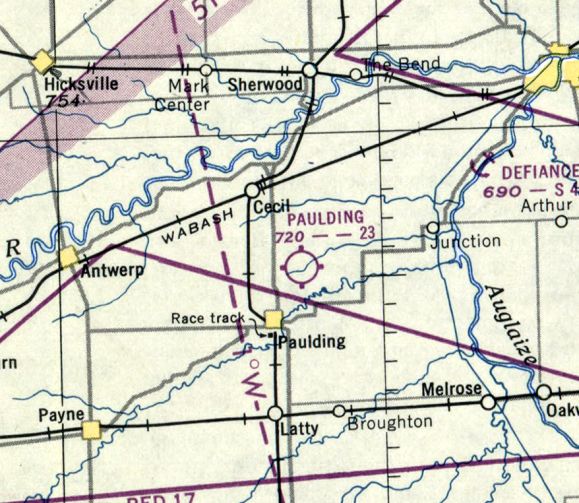
Abandoned & Little-Known Airfields:
Northwestern Ohio
© 2002, © 2016 by Paul Freeman. Revised 9/18/16.
This site covers airfields in all 50 states: Click here for the site's main menu.
____________________________________________________
Please consider a financial contribution to support the continued growth & operation of this site.
Bellefontaine Municipal (revised 11/29/13) - Camp Perry National Guard (revised 3/1/16) - Franklin Airport (revised 7/28/13) - Korn Field (added 8/2/15)
Lansdowne Airport (added 5/9/15) - Lima Airport / Allen County Airport (revised 9/30/14) - National Airport (revised 9/30/14)
Nickell Field (added 9/30/14) - Paulding Airport (added 9/18/16) - Sandusky Municipal Airport / Griffing Sandusky Airport (revised 6/5/16)
Stickney Avenue Airport (added 9/12/12) - Treaty City Airport (added 5/9/15)
Waco Aircraft Company / Troy-Waco Airport (revised 9/30/14) - Wapakoneta Airport (revised 1/17/15)
____________________________________________________
Paulding Airport (2H8), Paulding, OH
41.17, -84.555 (East of Fort Wayne, IN)

Paulding Airport, as depicted on the November 1950 Chicago Sectional Chart.
This small general aviation airport was evidently established at some point between 1946-50,
as it was not yet depicted on the June 1946 Chicago Sectional Chart.
The earliest depiction which has been located of Paulding Airport was on the November 1950 Chicago Sectional Chart.
It depicted Paulding Airport as having a 2,300' unpaved runway.
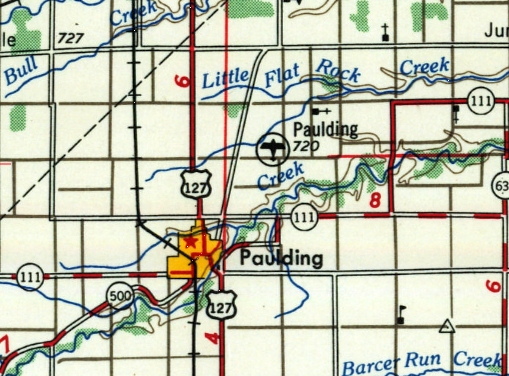
The earliest topo map depiction which has been located of Paulding Airport was on the 1956 USGS topo map.

The 1960 USGS topo map depicted Paulding Airport as having 2 perpendicular unpaved runways, and 3 small buildings on the south side.
According to its FAA Airport/Facility Directory data, Paulding Airport had an “activation date” of May 1972,
even though other sources show it existed for several decades before that.

The earliest photo which has been located of Paulding Airport was a 1994 USGS aerial view looking north.
It depicted Paulding Airport as having 2 perpendicular unpaved runways, with 2 light single-engine aircraft parked near some small buildings on the south side.
According to its FAA Airport/Facility Directory data, as of 2008 Paulding Airport had a total of 8 aircraft based on the field,
and it conducted an average of 40 takeoffs or landings per week.
The owner was listed as Jim Calvin, and the manager as Ron Weck.
Paulding was said to have a single 2,861 turf Runway 18/36, “in good condition”.

The 2016 Sectional Chart depicted Paulding Airport as having a 2,800' unpaved runway.
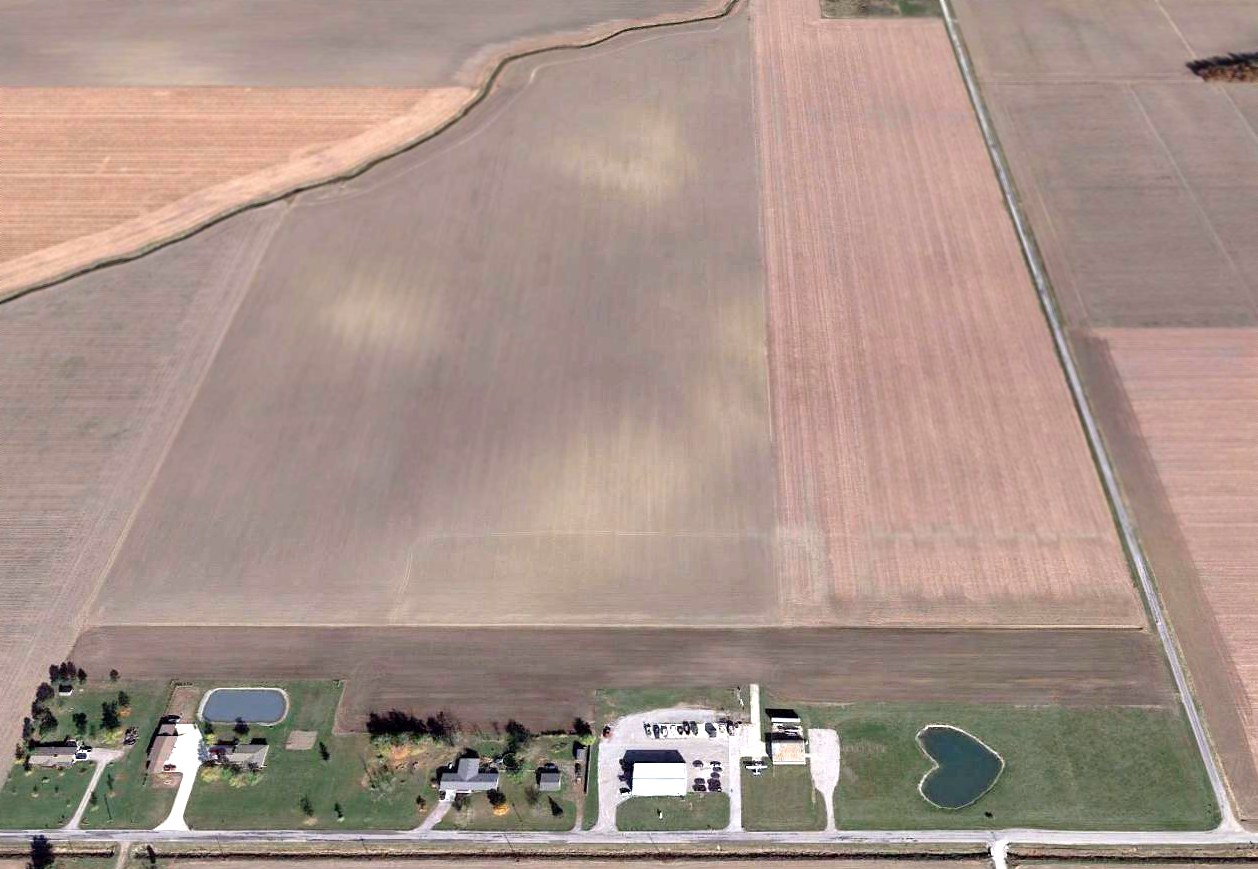
A 2016 aerial view looking north showed Paulding Airport's north/south runway was no longer perceptible, but the east/west runway remained intact.
One Cessna was still visible parked on the south side of the runway.
According to its FAA Airport/Facility Directory data, as of 2016 Paulding Airport was listed as “Airport closed indefinitely”.
Paulding Airport is located northwest of the intersection of Road 162 & Town Highway 119.
Thanks to Randy Coller for pointing out this airfield.
____________________________________________________
Korn Field, Jackson Center, OH
40.42, -84.08 (Northwest of Columbus, OH)
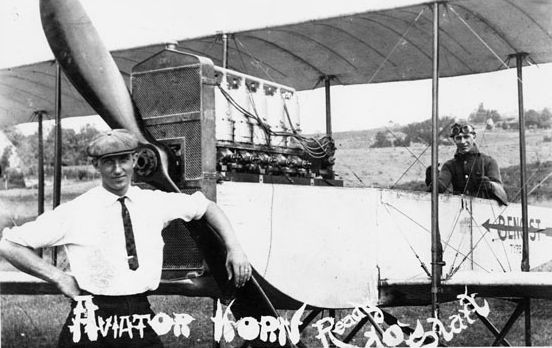
A circa 1912 photo of Milton Korn in front of a Benoist Type XII while his brother Edward is at the controls, presumably at Korn Field (courtesy of Jim Hackman).
According to the Historical Marker Project (courtesy of Jim Hackman), “The first airport in Shelby County & one of the earliest in OH
was opened July, 1908, by the Korn brothers, Edward & Milton.”
According to the Wright State Library (courtesy of Jim Hackman),
“Milt & Ed Korn began building flying machines in 1908.
Altogether they built 4 airplanes, of which the first 2 never got off the ground.
The 3rd one, powered with a marine motor, made successful flights in 1911, taking off & landing at Korn Airport.”
According to the Historical Marker Project (courtesy of Jim Hackman), “They flew the length of the field, a half mile in a half minute & landed safely.
Their plane was a pusher-type monoplane with a 34' wingspan,40 horsepower, water-cooled, 4-cylinder, 2-cycle engine, and weighed 650 pounds.”
According to the Wright State Library (courtesy of Jim Hackman),
“The 4th airplane, called a Benoist Type XII, was put together in 1911-12 out of parts from a number of different airplanes.
It was used in 1912 to carry the first air mail in the state of IL.”
The Wright State Library continued, “The Korn brothers’ only crash occurred on 8/13/1913.
With Edward at the controls & Milton riding as passenger, the Benoist Type XII plane crashed in an open field on George Linker’s property in Shelby County.
On August 18, Milton died from his injuries. Edward Korn’s injuries healed, but, haunted by the accident & the loss of his brother, he stopped flying.
From 1913-46, public operations & services at the Korn Airport were discontinued,
but a younger brother of the Korns, Arlington Korn, continued to fly, using the field as his base of operations.”
According to the Historical Marker Project, “It was used by the Flying Farmers organization, and following World War II, pilots were trained here under the G.I. Bill of Rights.”

The earliest photo which has been located showing the facilities of Korn Field was a circa 1948 aerial view (courtesy of Jim Hackman).
It depicted Korn Field as having 2 hangars (one of which had “Korn Field” painted on the roof) along with other building & a house.
A total of 5 light single-engine planes were parked on the field.
The Wright State Library continued, “In 1949, Ed Korn donated the Benoist Type XII
to the Smithsonian Institution’s National Air & Space Museum in Washington, DC, where it is now on permanent display.”
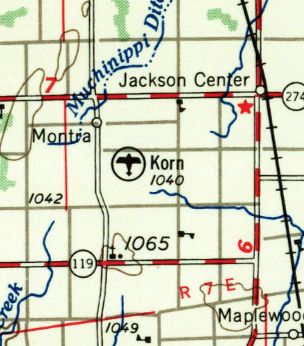
The earliest topo map depiction which has been located of Korn Field was on the 1956 USGS topo map.
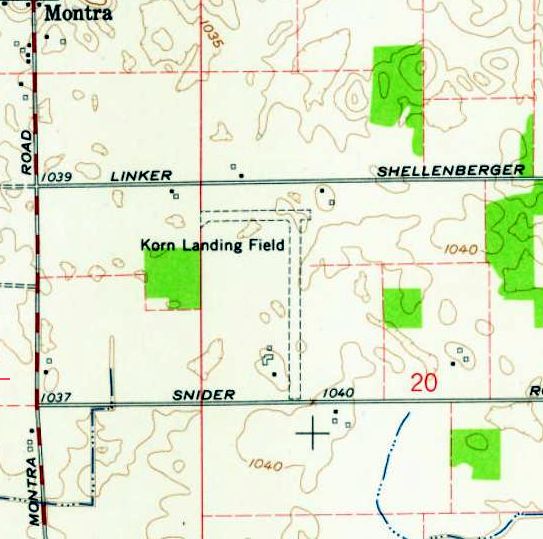
The 1961 USGS topo map depicted Korn Landing Field as having 2 perpendicular unpaved runways,
with 3 small buildings on the southwest side.
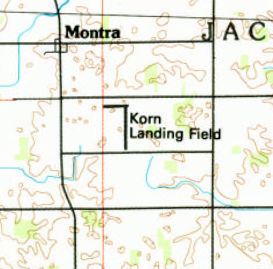
The 1989 USGS topo map still depicted Korn Landing Field as having 2 perpendicular runways.
A 1994 aerial view showed the site of the Korn Field runways remained clear, but there was no indication of any recent aviation usage.
The Wright State Library continued, “The Korn Airport property was later owned by Arlington’s son Wayne Korn until 2009.
It is now [as of 2013] part of Creative Plastics International, a business owned & operated by members of the Korn & Wurm families.”
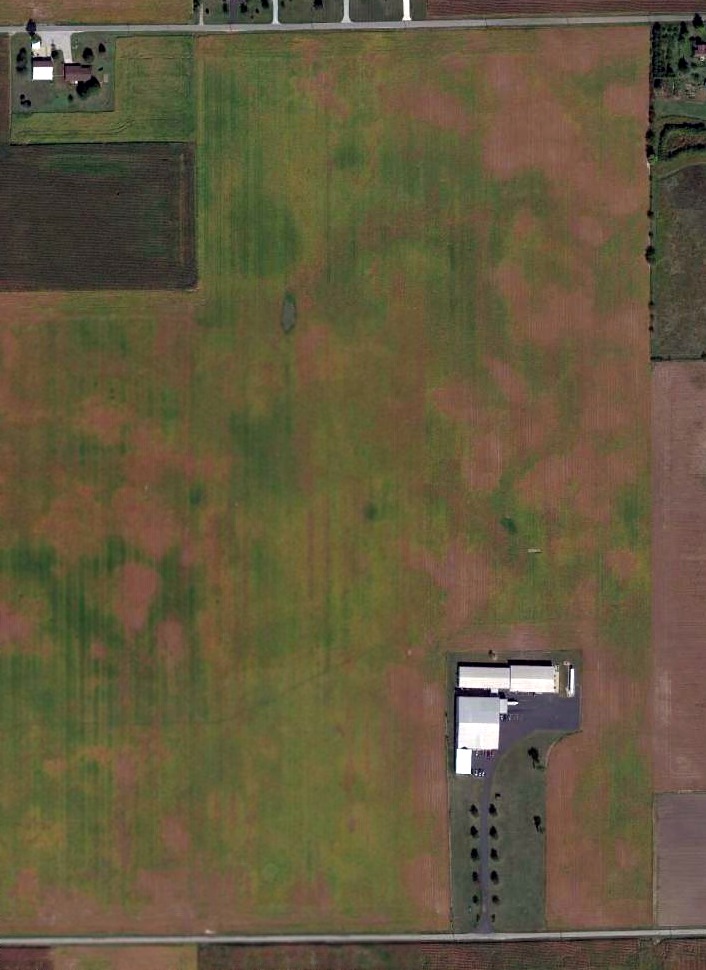
A 2014 aerial view of the site of Korn Field showed the airport buildings at the south end had been added onto,
and the runway area remained clear.
The site of Korn Field is located northeast of the intersection of Pasco-Montra Road & Snyder Road.
Thanks to Jim Hackman for pointing out this airfield.
____________________________________________________
Lansdowne Airport, Greenville, OH
41.43 North / 82.65 West (Northwest of Columbus, OH)
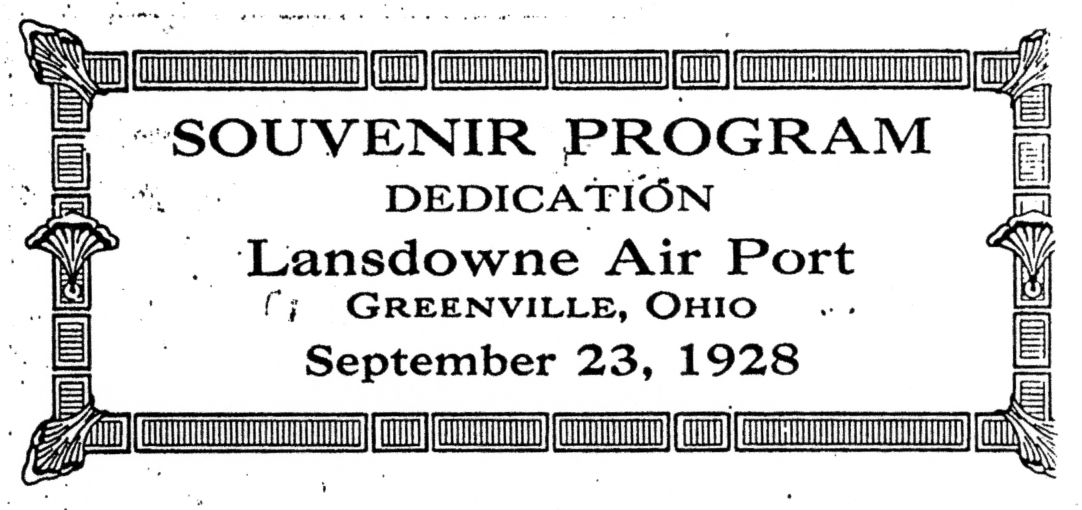
A Souvenir program of the 9/23/28 Dedication of Lansdowne Airport (courtesy of Jim Hocker).
This general aviation airport on the southeast side of the town of Greenville
was dedicated on 9/23/28, according to a Souvenir Program of the Dedication (courtesy of Jim Hocker).
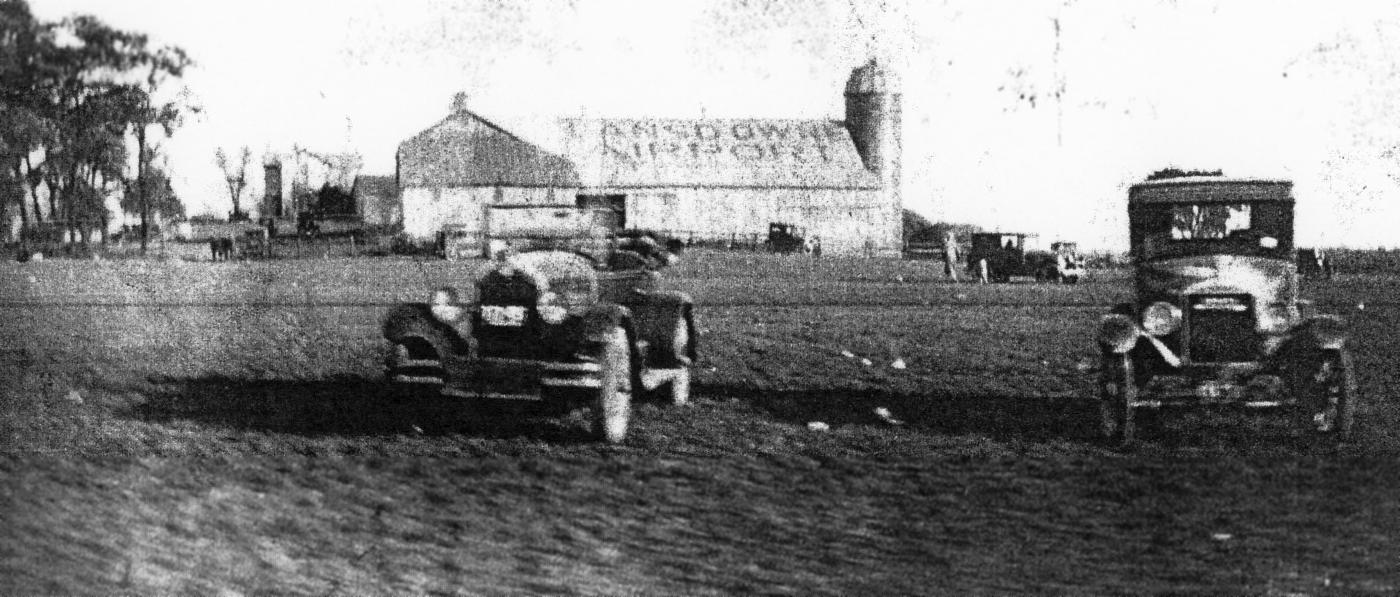
The earliest photo which has been located of Lansdowne Airport was an undated (circa 1920s/30s?) photo (courtesy of Jim Hocker) of a barn with “Lansdowne Airport” painted on its roof.
Lansdowne Airport may have gone through a period of closure during WW2, (like many other small civilian airports)
as it was not listed among active airfields in the 1945 AAF Airfield Directory (courtesy of Scott Murdock).
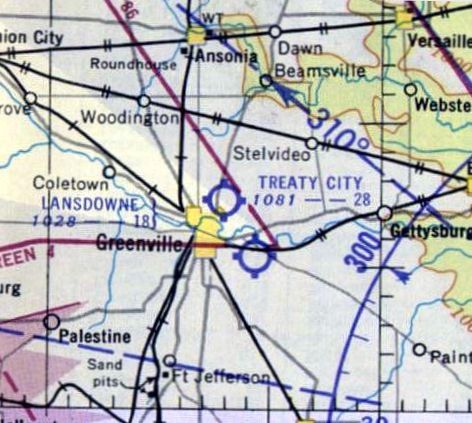
The earliest aeronautical chart depiction which has been located of Lansdowne Airport was on the 1953 Chicago Sectional Chart.
It depicted Lansdowne Airport as having a mere 1,800' unpaved runway.
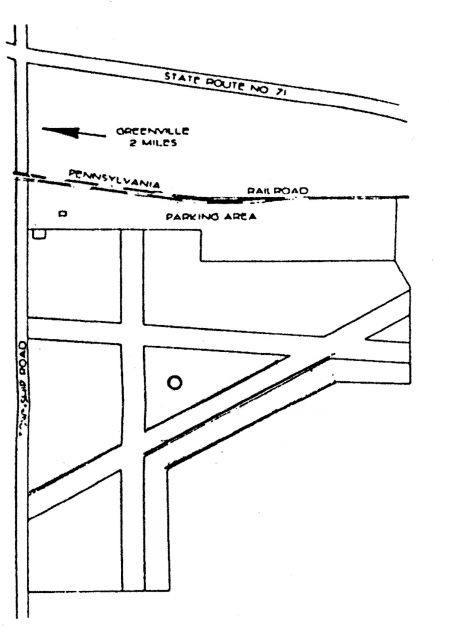
An undated diagram (courtesy of Jim Hocker) depicted Lansdowne Airport as having 3 runways,
and 2 small buildings on the northwest side.
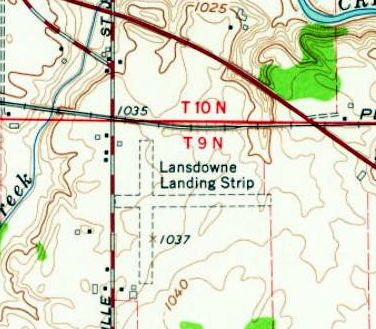
The 1961 USGS topo map depicted “Lansdowne Landing Strip” as having 2 unpaved perpendicular runways,
with a few small buildings on the northwest & southwest sides.
Lansdowne Airport was evidently closed (for reasons unknown) at some point between 1953-61,
as it was no longer depicted on the June 1961 Chicago Sectional Chart.
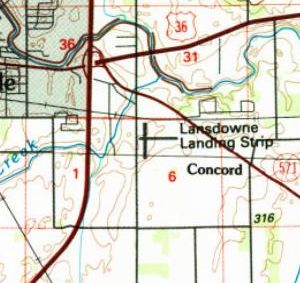
The 1989 USGS topo map still depicted 2 runways labeled as “Lansdowne Landing Strip”,
even though the airport had evidently been closed for at least 28 years by that point.

A 1994 USGS aerial view still depicted traces of 2 perpendicular unpaved runways at the site of Lansdowne Airport,
although a building had been built over the east end of the east/west runway.
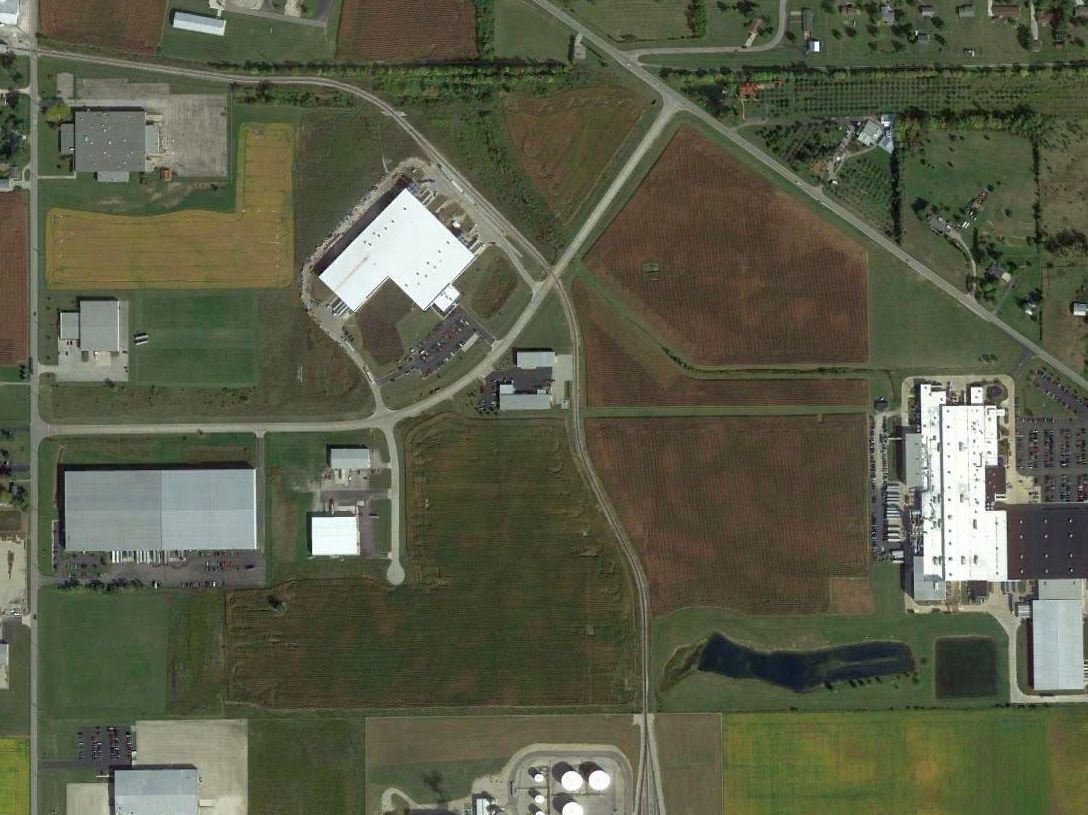
A 2014 aerial view of the site of Lansdowne Airport showed buildings & roads had covered most of the airport site,
but amazingly the outline of the east end of the former east/west runway is still recognizable as a gap in the planted crops.
The site of Lansdowne Airport is located east of the intersection of Jaysville - St. Johns Road & Lansdowne Road.
Thanks to Jim Hocker for pointing out this airfield.
____________________________________________________
Treaty City Airport, Greenville, OH
41.43 North / 82.65 West (Northwest of Columbus, OH)
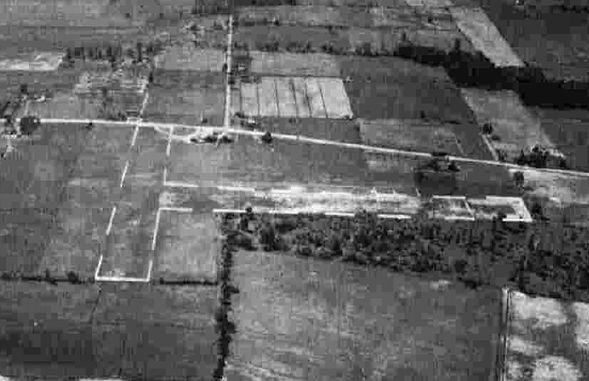
A 9/28/43 aerial view of Treaty City Airport from the 1945 AAF Airfield Directory (courtesy of Scott Murdock).
This general aviation airport was located on the northeast side of the town of Greenville.
The date of establishment of Treaty City Airport has not been determined.
The earliest depiction which has been located of Treaty City Airport was a 9/28/43 aerial view from the 1945 AAF Airfield Directory (courtesy of Scott Murdock).
It depicted Treaty City Airport as having 2 unpaved perpendicular runways.
The 1945 AAF Airfield Directory (courtesy of Scott Murdock) described Treaty City Airport
as a 67 acre irregularly-shaped field having 2 sod runways, measuring 1,980' north/south & 1,850' east/west.
The field was said to have 2 hangars, the largest being a 95' x 50' wood & metal structure.
Treaty City Airport was was described as being owned & operated by private interests.
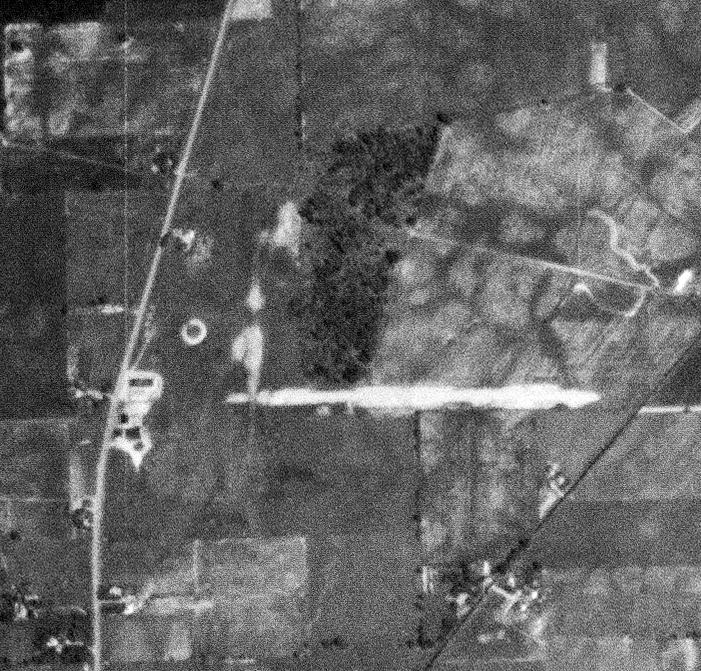
A 9/6/52 USGS aerial view depicted Treaty City Airport as having an unpaved east/west runway, with several small hangars on the west side.

The earliest aeronautical chart depiction which has been located of Treaty City Airport was on the 1953 Chicago Sectional Chart.
It depicted Treaty City Airport as having a 2,800' unpaved runway.
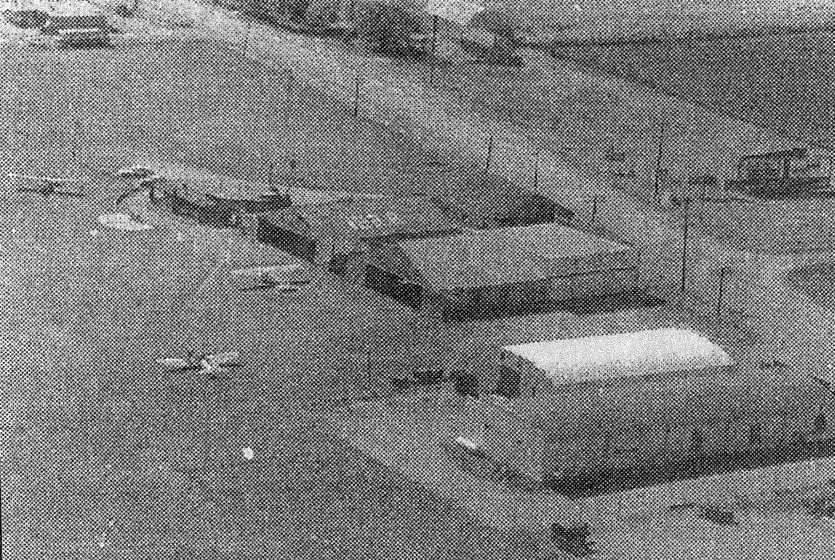
An undated aerial view of Treaty City Airport (courtesy of Jim Hocker) depicted 3 light aircraft parked near several hangars.
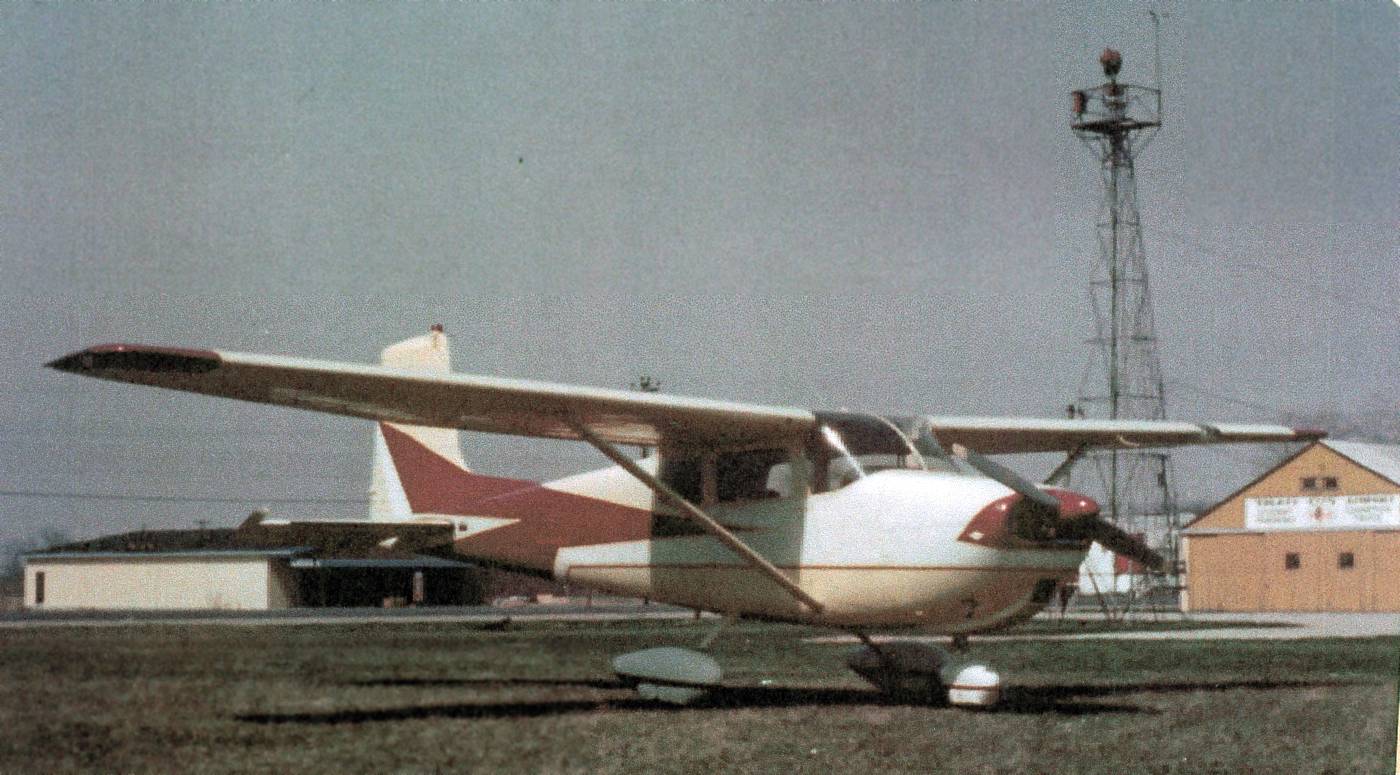
An undated photo (courtesy of Jim Hocker) of a Cessna 172 part-owned by Harry Campbell in front of the Treaty City Airport hangars & beacon tower.

The 1960 OH Airport Directory (courtesy of Jim Hocker) depicted Treaty City Airport as having 3 sod runways & several buildings on the west side.
It listed the manager as Mrs. Wm. Bleyle.
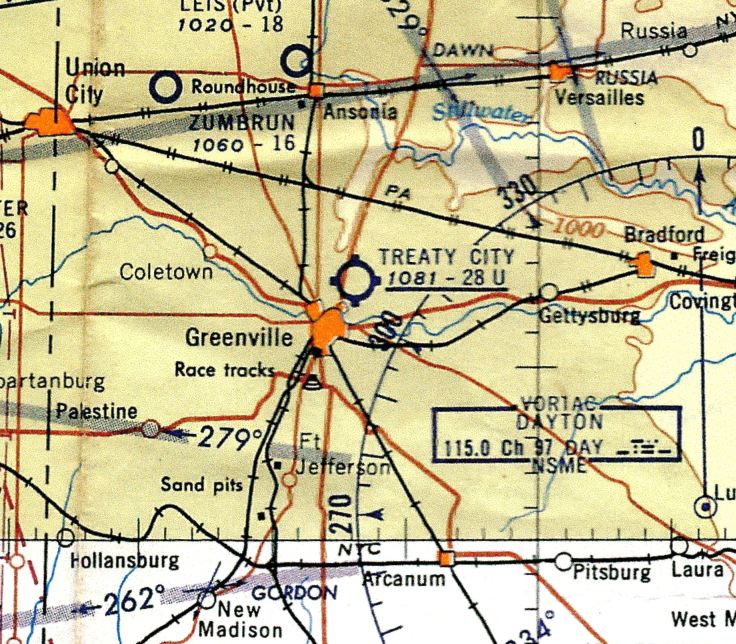
The last aeronautical chart depiction which has been located of Treaty City Airport was on the June 1961 Chicago Sectional Chart.
It depicted Treaty City Airport as having a 2,800' unpaved runway.
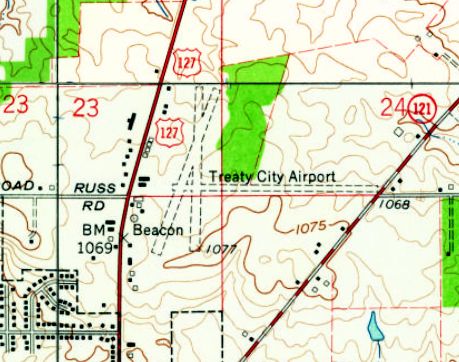
The 1961 USGS topo map depicted Treaty City Airport as having 3 unpaved runways,
and several small buildings & a beacon on the west side.

Treaty City Airport apparently lost 2 of its 3 runways at some point between 1961-73,
as the 1973 USGS topo map showed a large building had been built over the north portion of 2 of the runways,
and only the east/west runway was still depicted.
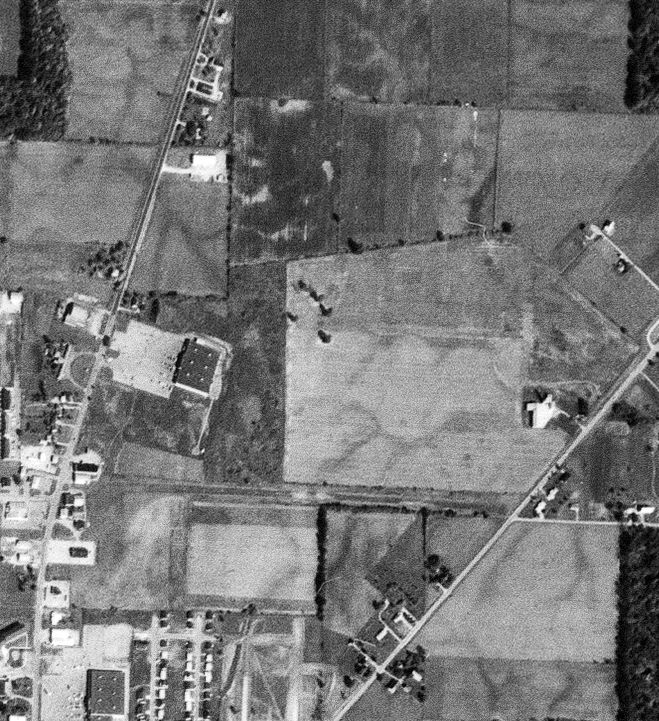
The last photo which has been located showing Treaty City Airport still in operation was a 10/14/73 USGS aerial view.
It depicted the single east/west unpaved runway, and the hangars on the west side.
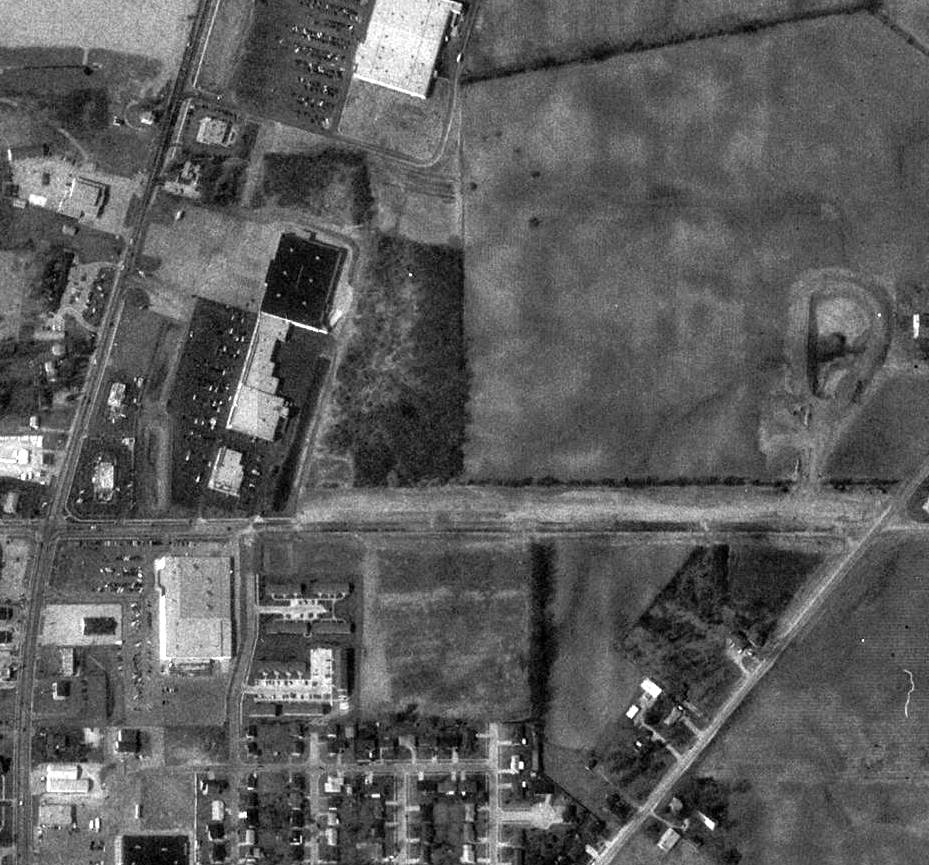
Treaty City Airport was evidently closed at some point between 1973-94,
as a 1994 USGS aerial view showed another large building had been constructed over the west portion of the east/west runway.
But the eastern portion of the east/west runway remained recognizable, along with the hangars on the west side.

A 2014 aerial view of the site of Treaty City Airport showed buildings had covered the remainder of the east/west runway,
with several hangars on the west side remaining as the last trace of this airport.
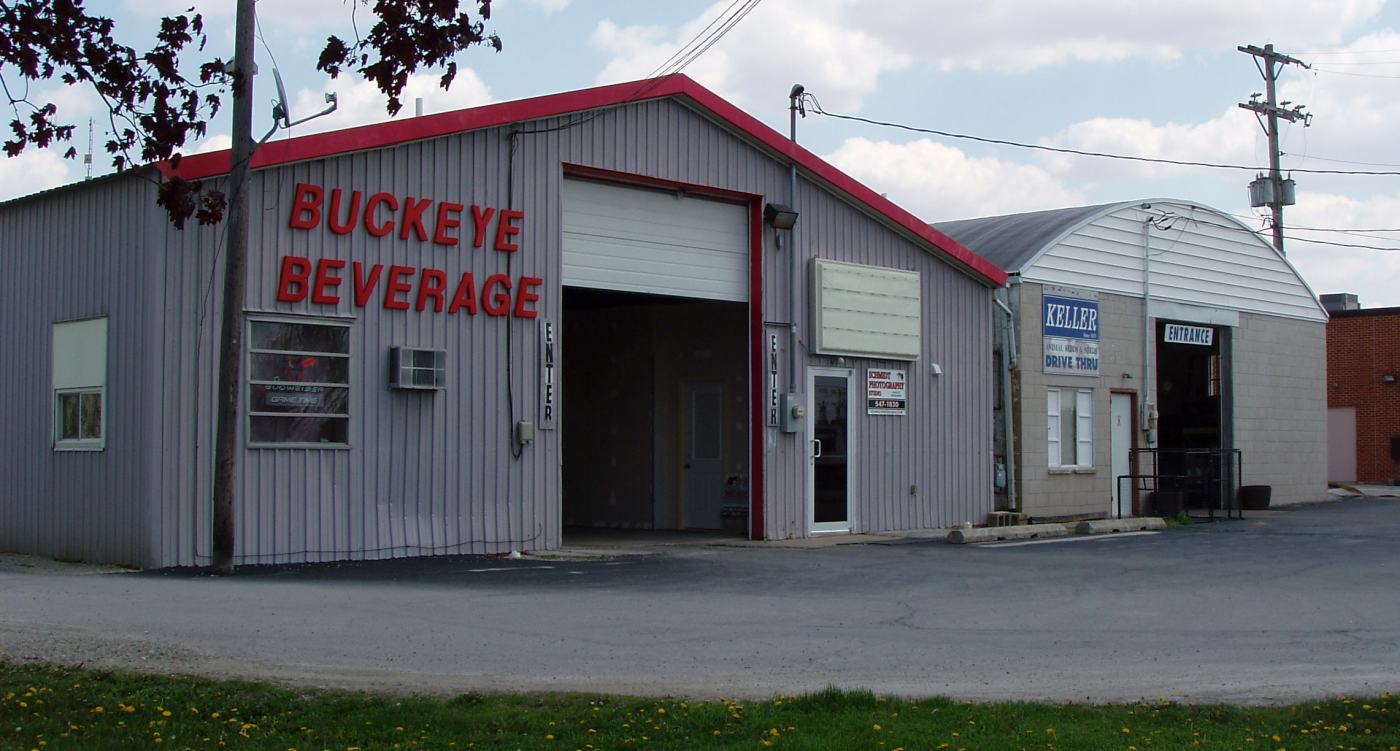
A 5/2/15 photo by Jim Hocker of 2 former Treaty City Airport hangars.
Jim observed, “Both are drive-through structures, one selling beverages & the other animal feed.”
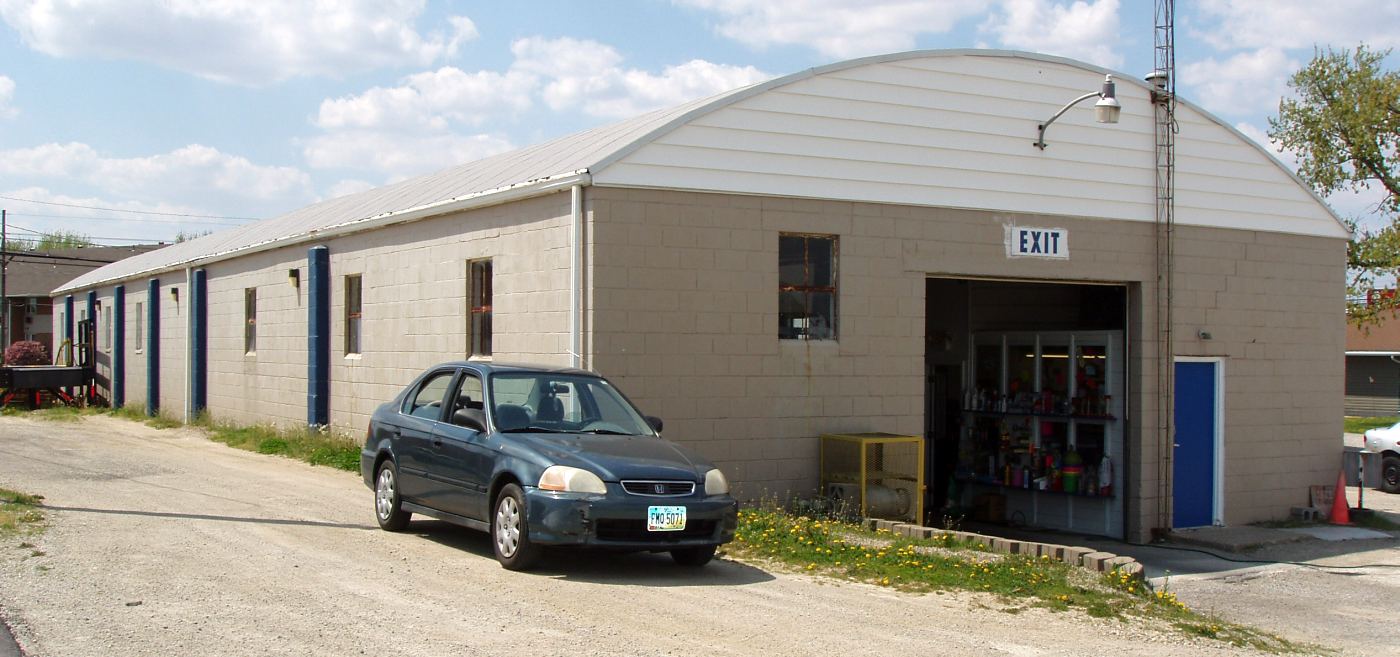
A 5/2/15 photo by Jim Hocker of the back side of a former Treaty City Airport hangar.
The site of Treaty City Airport is located east of the intersection of Wagner Avenue & Russ Road.
Thanks to Jim Hocker for pointing out this airfield.
____________________________________________________
Sandusky Municipal Airport / Griffing Sandusky Airport (KSKY), Sandusky, OH
41.43, -82.65 (Northwest of Columbus, OH)
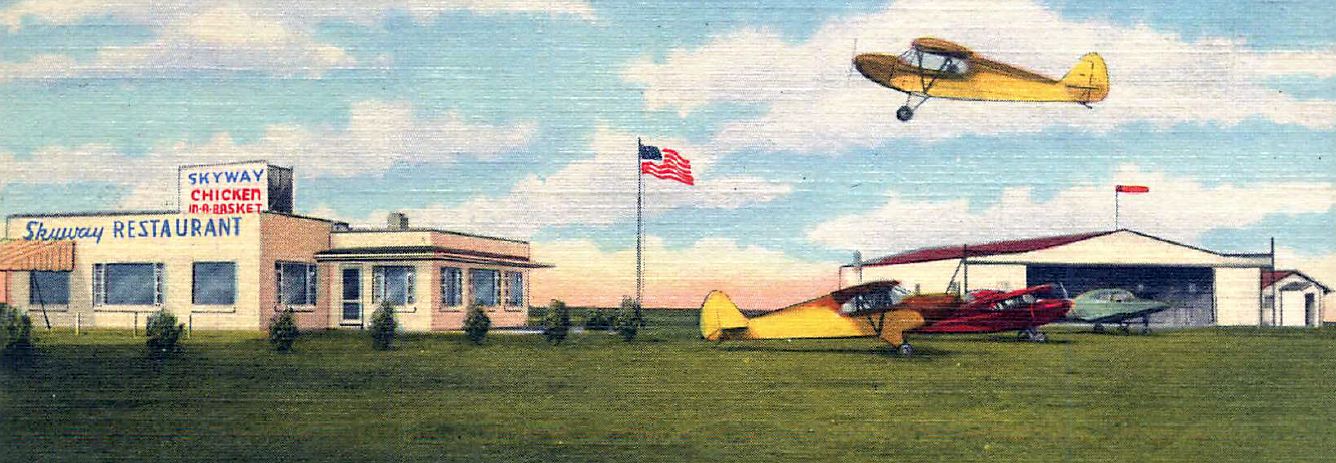
An undated (circa 1950s?) photo of the Skyway Restaurant & several planes & a hangar at Sandusky Airport (courtesy of Daniel Frohman).
According to its FAA Airport/Facility Directory entry, Sandusky Municipal Airport was established in December 1937.
It was located directly along the shore of Lake Erie, southeast of Sandusky.
According to Tom Griffing (via Darren Gaines), Griffing Sandusky Airport was started by his father Harry Griffing in 1937.
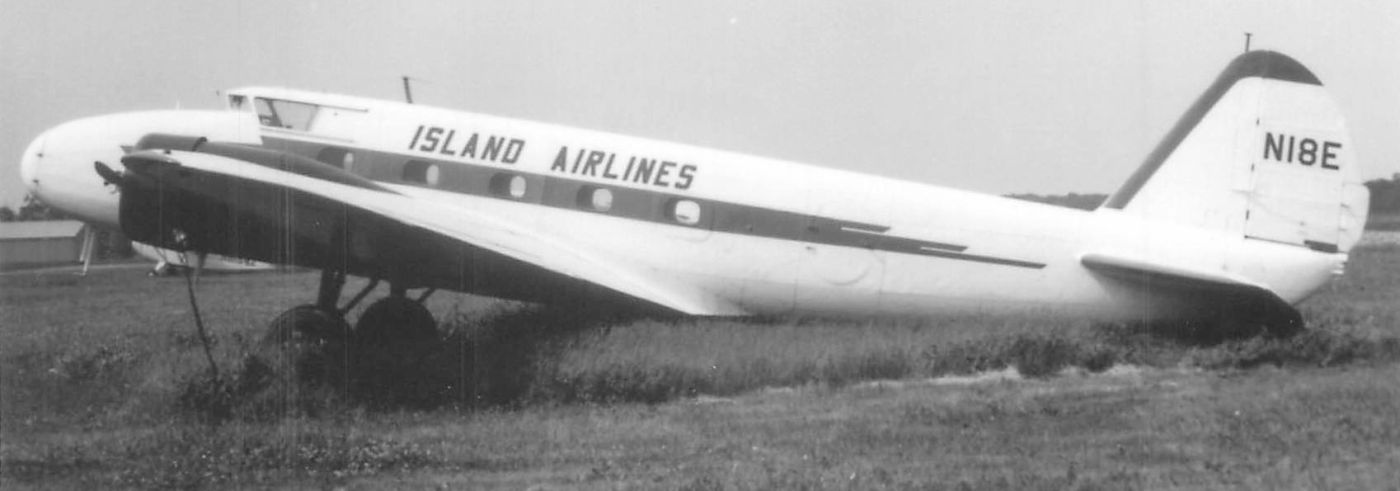
An undated (circa 1950s?) photo of an Island Airways Boeing 247D at Sandusky Airport (courtesy of Daniel Frohman).
Daniel reported, “The Boeing was based at Sandusky & flown where needed, mostly the Lake Erie islands.”
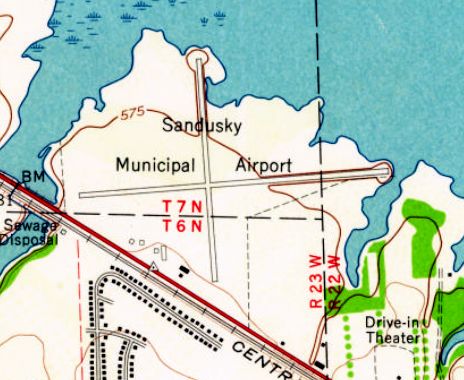
The 1959 USGS topo map depicted Sandusky Municipal Airport as having 2 paved perpendicular runways, with 6 small buildings on the southwest side.

The earliest photo which has been located of Griffing Sandusky Airport was a 1960 USGS aerial view.
It depicted Griffing as having 2 perpendicular paved runways, with a ramp with several hangars & aircraft on the southwest side.
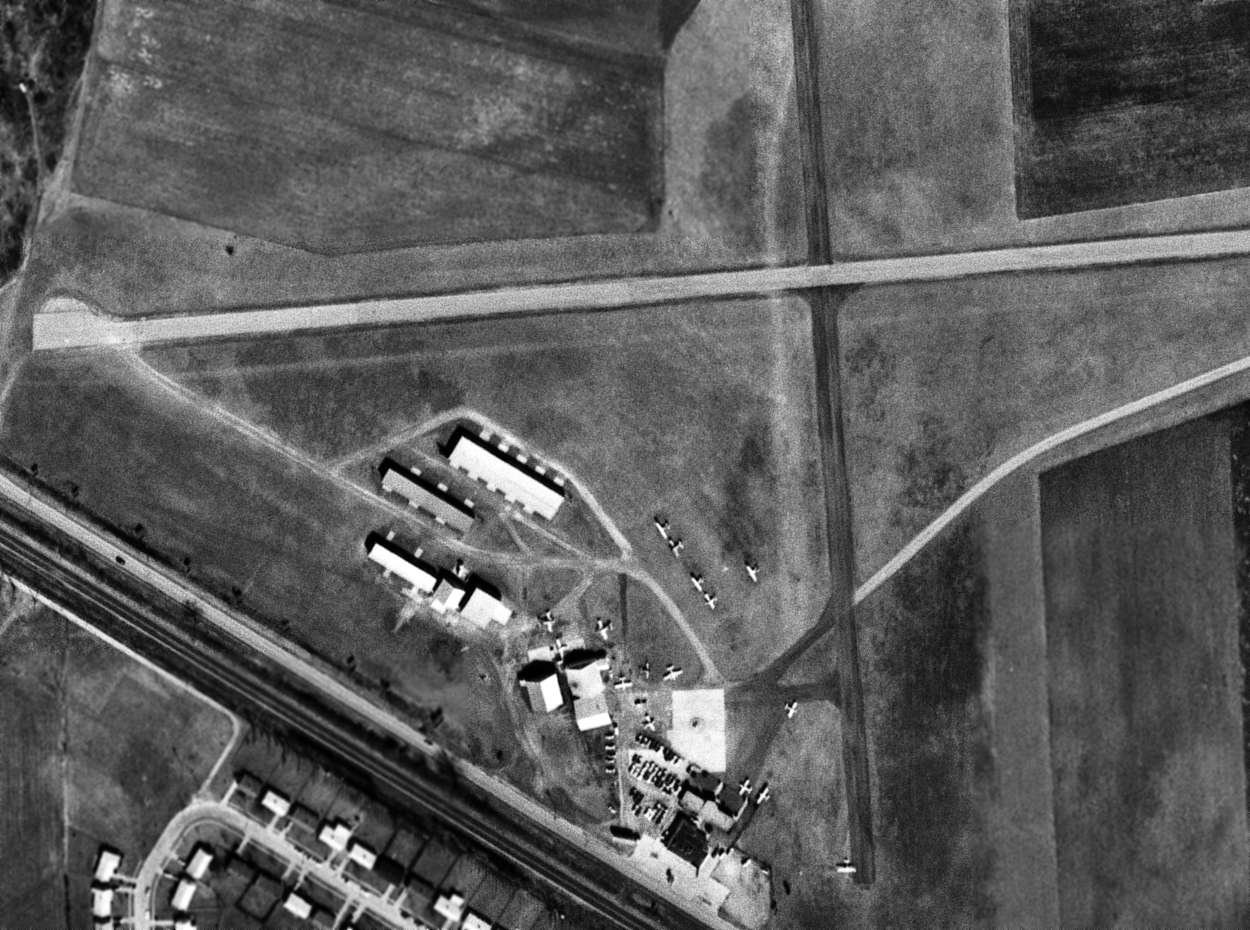
A 1969 USGS aerial photo depicted a dozen light aircraft parked amidst the hangars on the southwest side of Griffing Sandusky Airport.

A 1996 photo by Daniel Frohman of a Cessna 414 at Sandusky Airport. Daniel reported, “The 414 is one of the early corporate planes I flew.”

A 2007 aerial view looking southeast at a large number of planes gathered for a fly-in at Griffing Sandusky Airport.

A circa 2010 aerial view looking north showed only a single plane visible at Griffing Sandusky Airport.
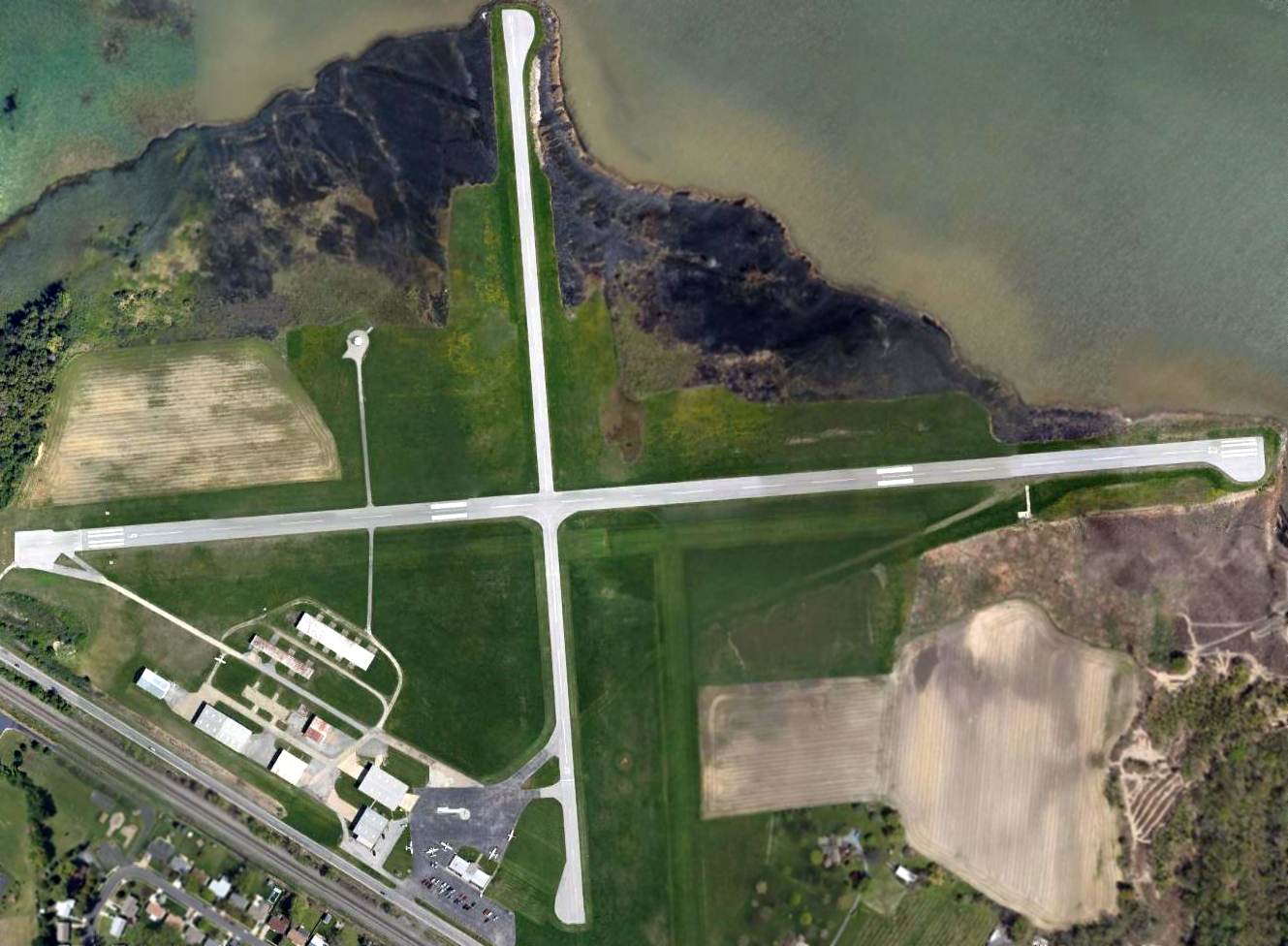
A 2012 aerial view showed 6 light aircraft at Griffing Sandusky Airport.
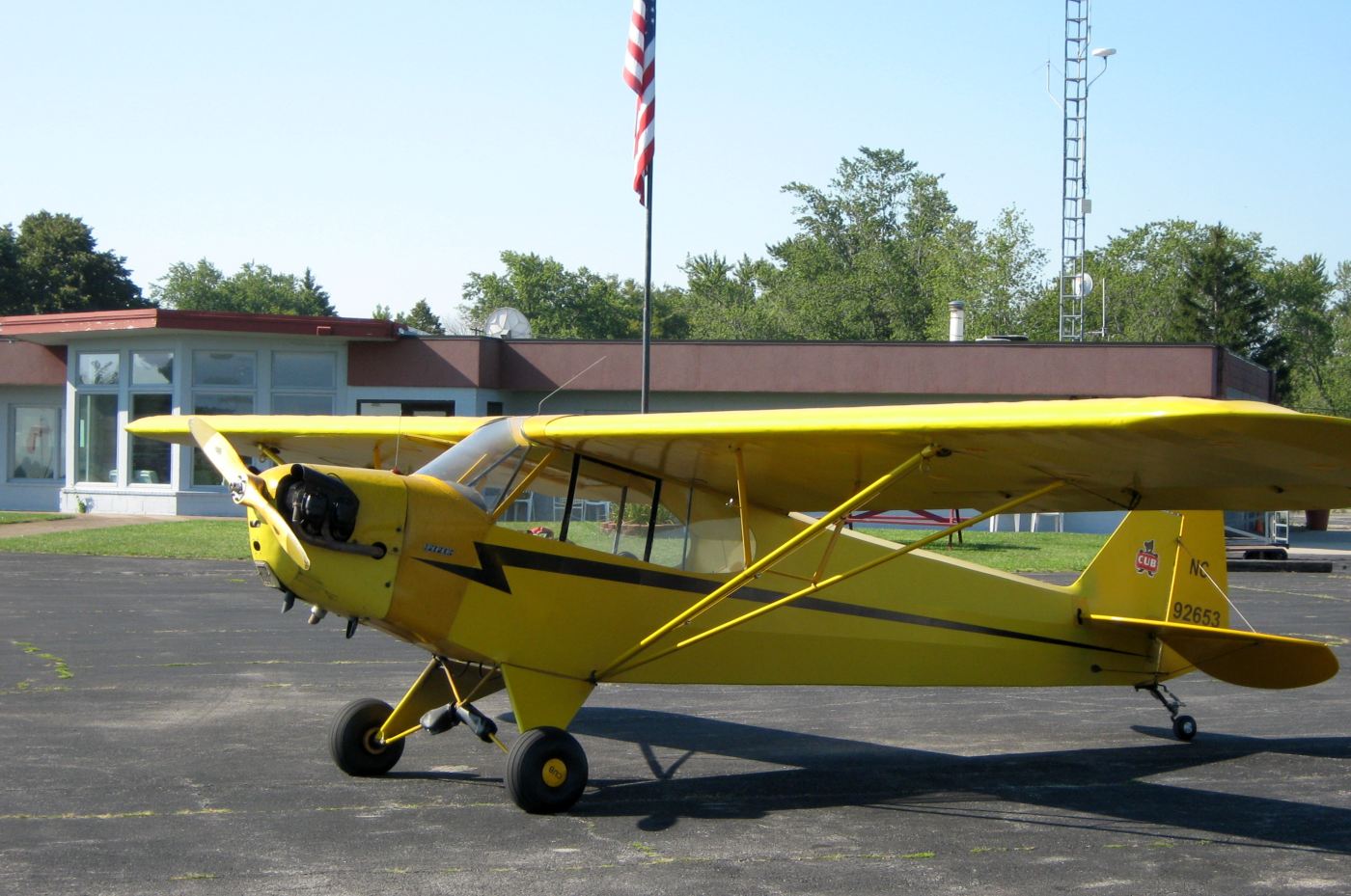
The last photo which has been located showing an aircraft at Griffing Sandusky Airport is an August 2012 photo by Darren Gaines of his beautiful Piper Cub during a fuel stop.
Darren reported, “Tom Griffing is loitering in the terminal when I walk in. We discussed the closure of this historic flying field started by his father, Harry in 1937.
Griffing Flying Service is moving the operation to Port Clinton Airport (PCW) sometime in 2013.”
According to its FAA Airport / Facility Directory data, as of 8/30/13 Griffing Sandusky Airport was said to conduct an average of 307 takeoffs or landings per day.
Griffing Sandusky Airport was officially closed on 12/31/13, and its instrument approach procedures were cancelled.
However some aircraft remained on the field, and it continued to be depicted on aeronautical charts & listed in the FAA Airport / Facility Directory.
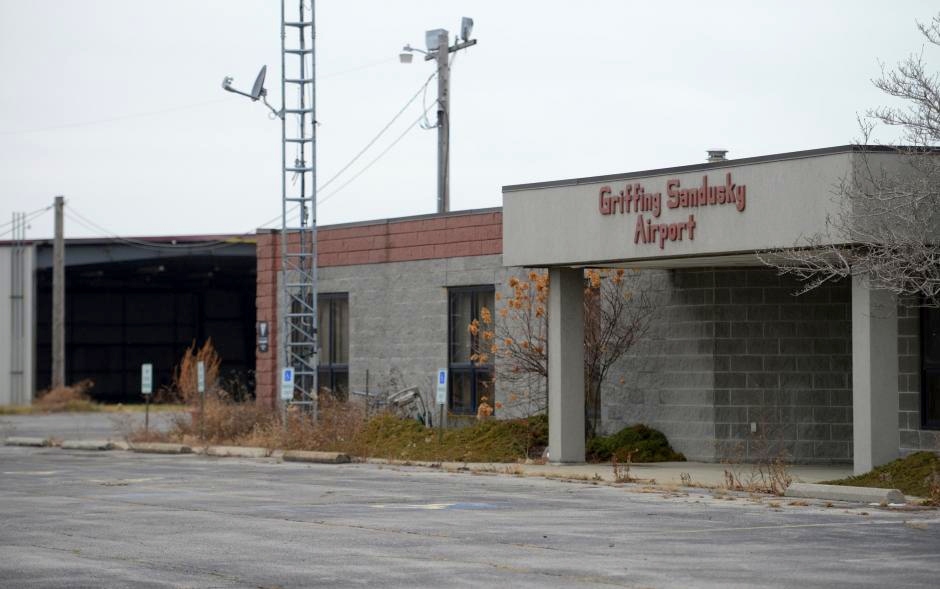
A sad 2014 photo of Griffing Sandusky Airport's terminal building, having seen better days.
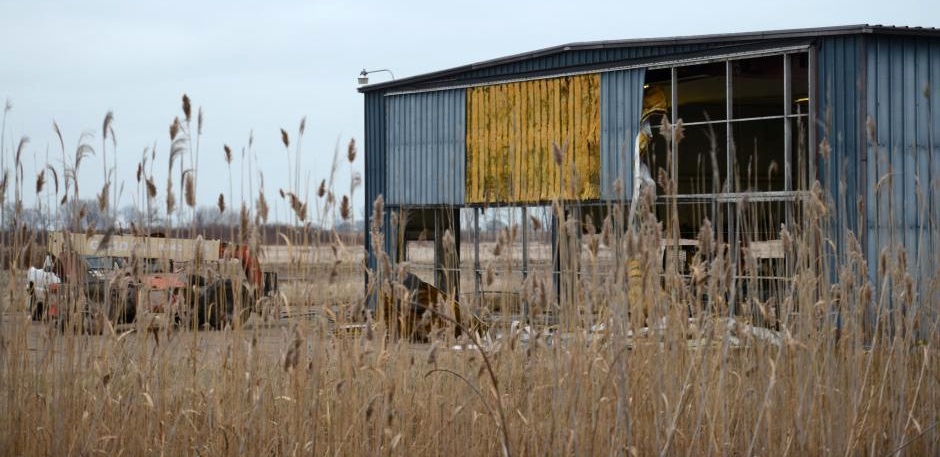
A 2014 photo of a Griffing Sandusky Airport hangar in the process of being demolished.

A 2014 photo of a Griffing Sandusky Airport taxiway.
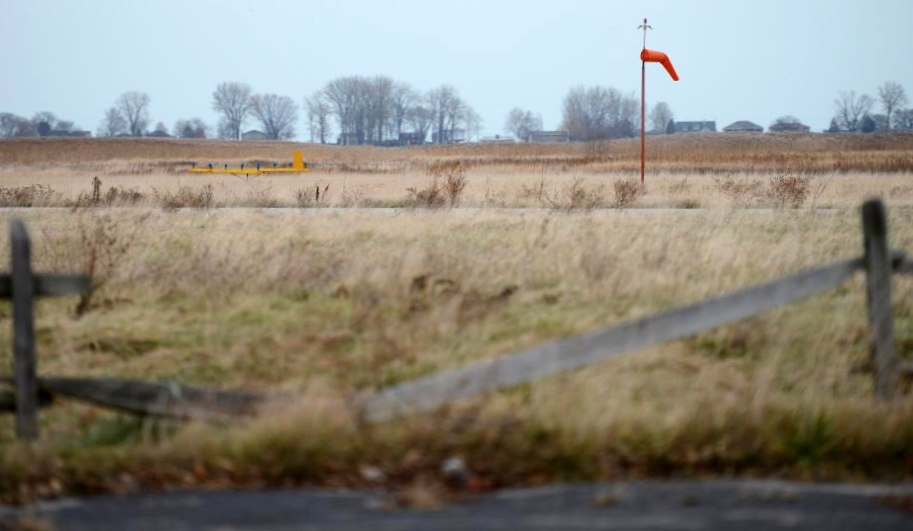
A 2014 photo of the windsock & illuminated wind direction indicator at Griffing Sandusky Airport.
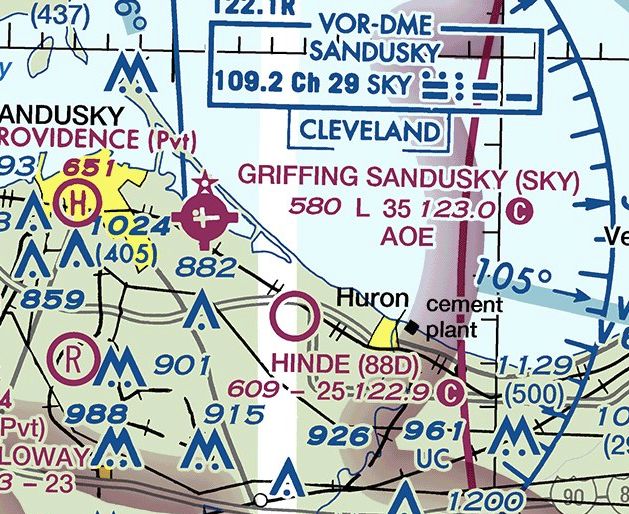
Showing that you can't always trust aeronautical charts, the 2015 Sectional Chart continued to depict Griffing Sandusky Airport as an open airport,
even though it had been closed for more than a year by that point.
Griffing Sandusky Airport continued to be listed in the FAA Airport / Facility Directory as of 2015.
It was described as being comprised of 133 acres, and having 2 asphalt runways: 3,559' Runway 9/27 & 2,593' Runway 18/36.
The owner was listed as Griffing-Sandusky Airport Inc., and the manager listed as Tom Griffing.
Griffing Sandusky Airport was said to be home to 44 aircraft.
Daniel Frohman reported in 2016, “Griffing Sandusky Airport: The property has been sold for a large sports complex now under construction.
All runways & taxiways have been removed as well as all remaining buildings. Nothing now but a pile of dirt!
This was a favorite airport of mine as I learned to fly there & made corporate aviation my career.”
Randy Coller reported in 2016, “In June I ran into Tom Griffing (former owner of Griffing Sandusky Airport).
He indicated the airport had been sold to Cedar Point Amusement Park.
I visited the site 6/17/16 & lots of construction activity was underway, not airport related.”
Griffing Sandusky Airport is located east of the intersection of Cleveland Road & East Shoreway Drive.
Thanks to Aaron Swank for pointing out this airfield.
____________________________________________________
40.55 North / 83.87 West (Northwest of Columbus, OH)

An undated (circa 1950s?) photo (courtesy of David Moore via Jim Hackman) of a Cessna 170 & Piper Cub in front of the Nickell Field gas pump.
According to Jim Hackman, “Bernite & Riger Nickell owned & operated a popular grass field providing fuel, hangar, and airplane rentals.
For obvious reasons it was often called '5 Cent Field'.
In 1955 they began their cropdusting service.
Bernita was a pioneer female agricultural pilot. Even today it is rare to find a lady in a duster.
They operated Super Cubs, Pawnees, a Grumman Ag Cat, and even a Piper Cherokee with spray booms.
Roger did maintenance & loading while Bernita did the majority of the flying.”
Jim continued, “Bernita Nickell was a local legend.
The rumors were that Roger [Nickell] was unable to read well enough to take & pass the Commercial [pilot's license] written exam.
The Nickells & their family farmed nearly 200 acres.
Roger apparently did the flying on the family land; Bernita did the outside customers.
When not cropdusting, '5 Cent Field' was a good spot to get coffee & stories.”
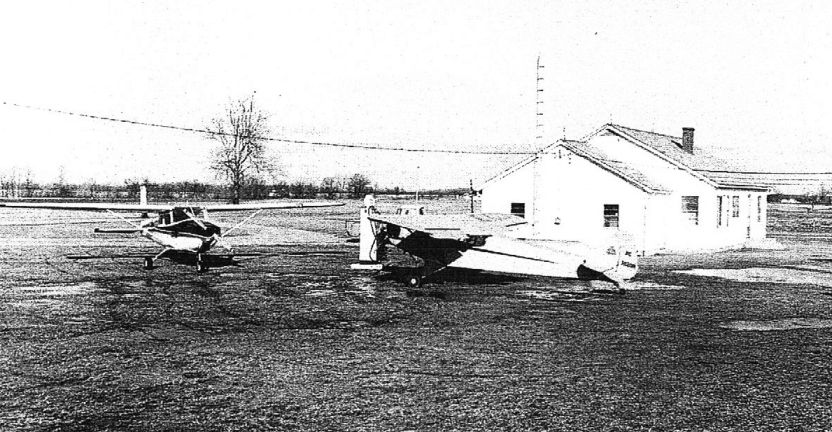
An undated (circa 1950s?) photo (courtesy of of David Moore via Jim Hackman) of a Cessna 170 & Piper Cub in front of the Nickell Field gas pump.
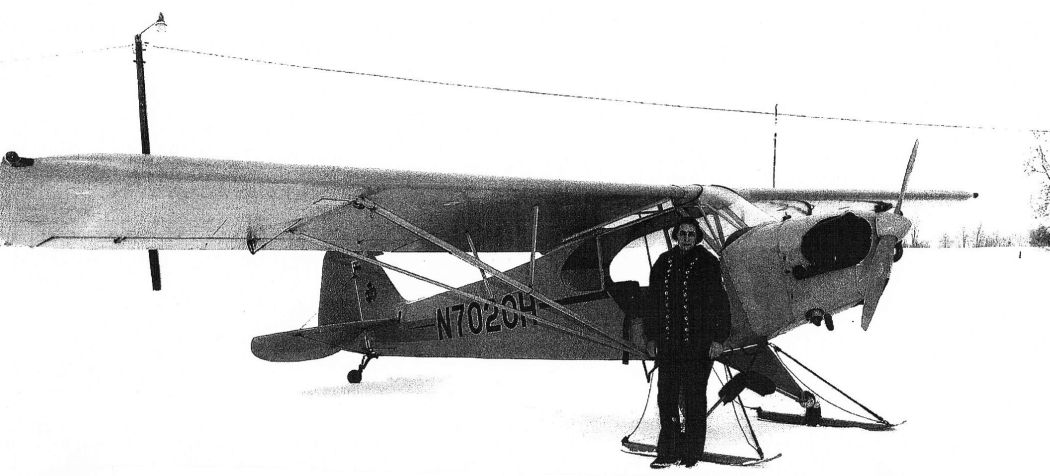
An undated (circa 1950s?) photo (courtesy of of David Moore via Jim Hackman) of Bernita Nickell in front of her ski-equipped 1946 Piper Cub.
Jim Hackman recalled, “Flying in winter in Ohio from grass airports made staying current & having some fun a challenge.
There were 'Cub Tracks' on many local farms from visiting pilots who rented this Cub. Remember, no brakes!”

The earliest aerial view which has been located of Nickell Field was a 5/8/59 USGS aerial view.
It depicted Nickell Field as a single grass north/south runway, with a few small buildings at the northwest end.
There were no aircraft visible on the field.
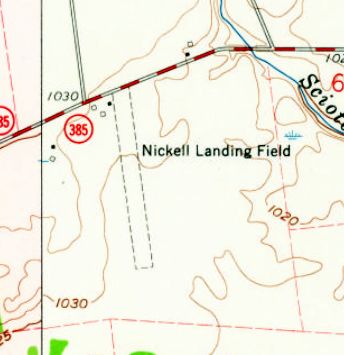
The 1960 USGS topo map depicted “Nickell Landing Field” as a single unpaved north/south runway, with a few small buildings at the northwest end.
Jim Hackman recalled, “They had annual fly-in breakfasts.
I flew in for breakfast on 5/19/63 in Colt N5033Z while enroute back to Phoenix.
A non-profit sponsored & served the breakfasts in their hangar... Flying Farmers? Lions Club?”

An undated (circa 1960s?) photo (courtesy of of David Moore via Jim Hackman) of Bernita Nickell on her Piper Pawnee cropduster.
Jim Hackman recalled, “There were not many female agricultural pilots in the 1960s. Note the helmet.”
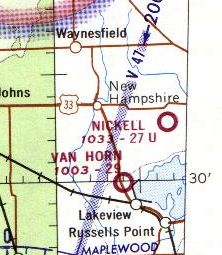
The only aeronautical chart depiction which has been located of Nickell Field was on the 1969 Chicago Sectional Chart,
which depicted Nickell as having a 2,700' unpaved runway.

The last photo which has been located showing aircraft at Nickell Field was a circa 1970 photo (courtesy of of David Moore via Jim Hackman) of an Open House,
showing a Cessna 172, Piper Cub, Ercoupe, and Piper Pawnee in front of 2 hangars.
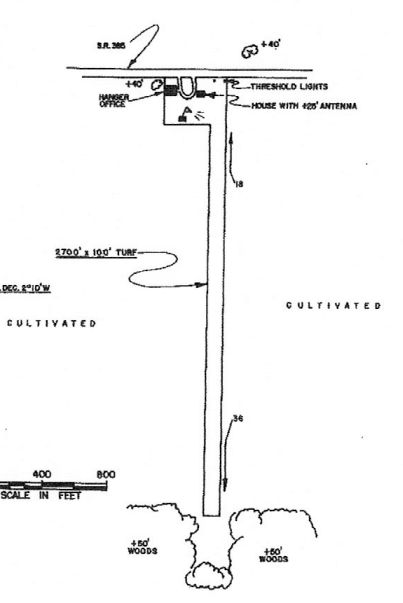
The 1974 OH Airport Directory (courtesy of the Ohio Department of Aviation via Jim Hackman) depicted Nickell Field as having a 2,700' sod Runway 18/36.
It listed the owner as Roger & Bernita Nickell, and the Fixed-Base Operator as Nickell Flying Service – Aerial Application.
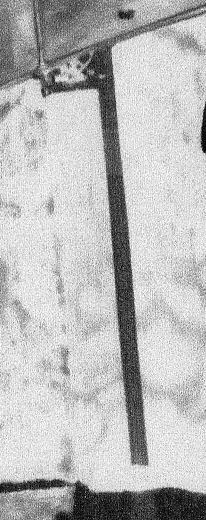
A 6/12/79 aerial view (courtesy of the Ohio Department of Aviation via Jim Hackman) depicted Nickell Field
as having a single grass north/south runway, with a few small buildings at the northwest end.
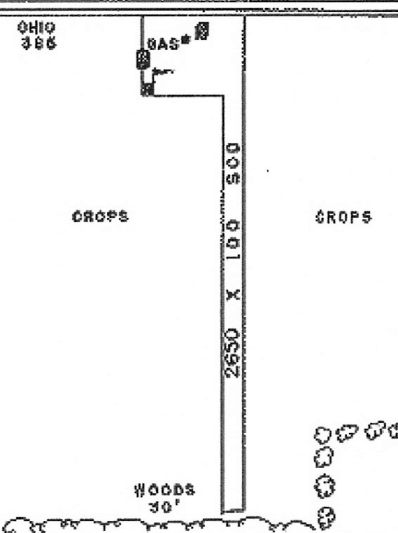
The last depiction which has been located of Nickell Field was in the 1981 OH Airport Directory (courtesy of the Ohio Department of Aviation via Jim Hackman).
It depicted Nickell Field as having a 2,650' sod Runway 18/36, and remarked, “Lights on west side of runway.”
Jim Hackman recalled, “It was local knowledge that there were only lights on one side!”
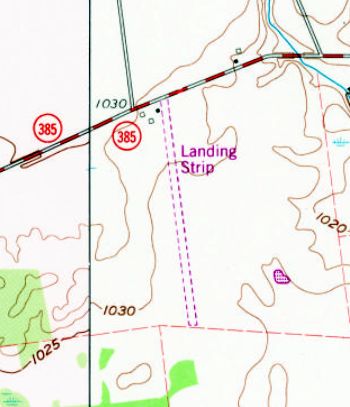
Nickell Field may have closed at some point between 1981-82, as it was still depicted on the 1982 USGS topo map,
but labeled simply as “Landing Strip”.
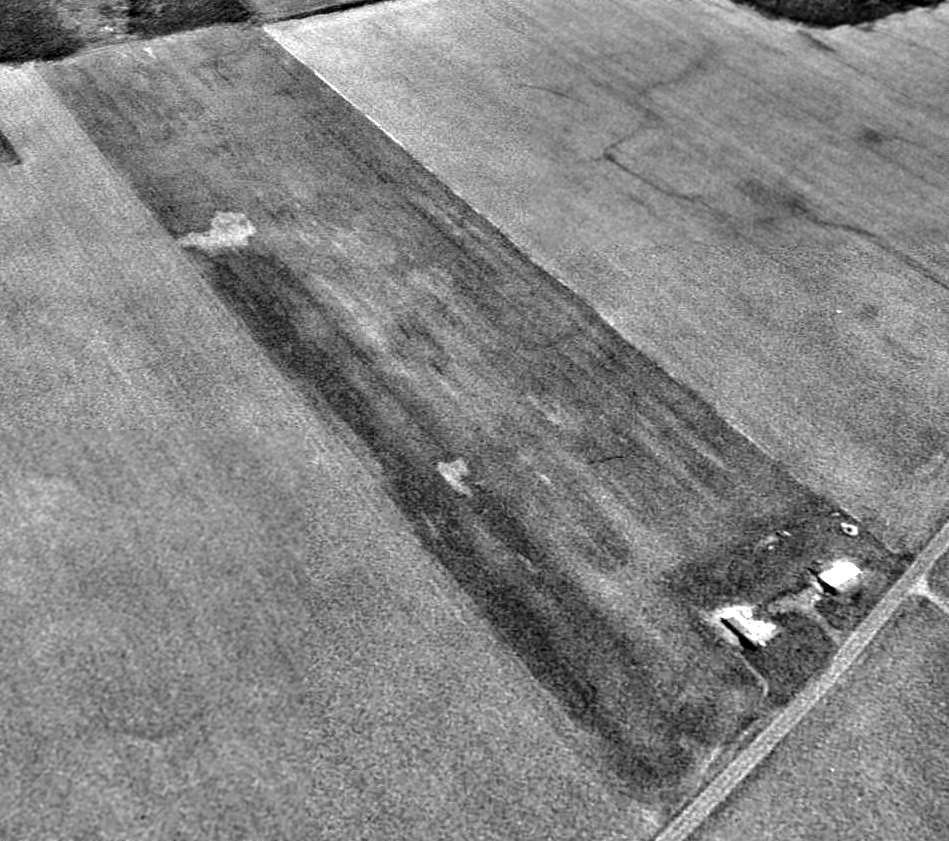
A 1994 USGS aerial view looking southwest showed the site of Nickell Field remained clear, but with no indication of any recent aviation use.

A 2012 aerial view looking southwest showed the site of Nickell Field remained clear, but with no indication of any recent aviation use.
The site of Nickell Field is located south of the intersection of Route 385 & Route 15.
Thanks to Jim Hackman for pointing out this airfield.
____________________________________________________
Wapakoneta Airport / Port Koneta, Wapakoneta, OH
40.6 North / 84.18 West (South of Toledo, OH)

A postmark commemorating the 9/8/46 Airport Dedication & Airshow at Port Koneta.
Photo of the airport while in use has not been located.
According to “Memories of Port Koneta” by Richard Schwer (courtesy of Jim Hackman),
“It all started during the spring & summer of 1946.
A group of local people built an airport north of Wapakoneta on what was know as 'the Brewery Road' now known as the Wapakoneta-Cridersville Road.
The original hangar, a long wooden building that extends to the east from near the road, was the only building that was there in 1946.”
The most famous product of Wapakoneta Airport was the man who would later be first to walk on the moon, astronaut Neil Armstrong.
According to Wikipedia, “[Neil] Armstrong took flying lessons at the grassy Wapakoneta airfield.
He earned a student flight certificate on his 16th birthday [8/5/46], then soloed later in August; all before he had a driver's license.”
According to “Memories of Port Koneta” by Richard Schwer (courtesy of Jim Hackman),
“It was estimated by the Wapakoneta Daily News that 10,000 persons visited Port Koneta airfield on 9/8/46 for the dedication of the new airport.
Spectators were entertained by the U.S. Army Air Force show with a thrilling aerobatic performance.
On exhibit were many planes & a helicopter which made it a most successful & gratifying event.”
According to “Memories of Port Koneta” by Richard Schwer (courtesy of Jim Hackman),
“The original air field only lasted about 18 months & was closed due to the lack of support by the people.
The original thought behind the opening of the airport was that many of the returning WW2 pilots would want & need a place to continue flying,
which turned out to be far from the truth.”
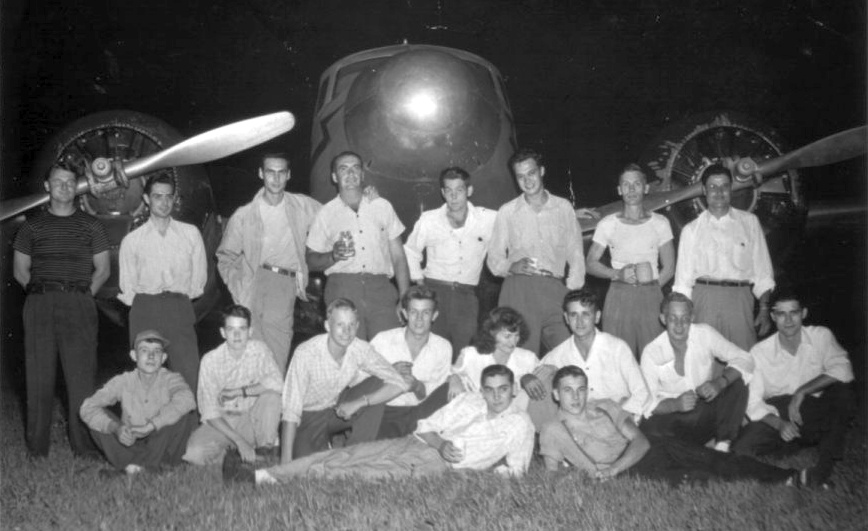
A 1946 photo of Wapokoneta's flight class (The "Port Koneta Gang") in front of a Cessna T-50 (courtesy of Jim Hackman).
Wapokoneta's eventual most famous flight student was Neil Armstrong (on bended knee, 3rd from left), who would go on to become the 1st man to walk on the moon.
According to “Memories of Port Koneta” by Richard Schwer (courtesy of Jim Hackman),
“The building on the south side of the hangar was added in the 1950s
when the airport was reopened for a few short years by Burdette Metzger, a Wapakoneta man.”
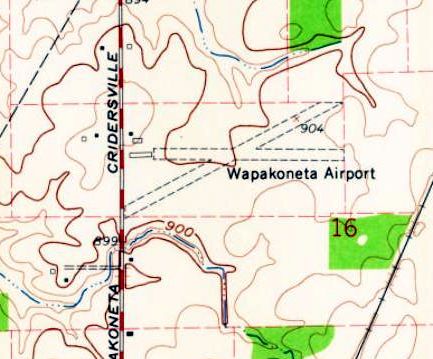
The earliest map depiction which has been located of Wapakoneta Airport was on the 1961 USGS topo map.
It depicted Wapakoneta as having 2 unpaved runways, with 3 small buildings on the west side.
Jim Hackman recalled, “Wapakoneta Airport... I got my Certified Flight Instructor [rating] there & instructed in 1962.”
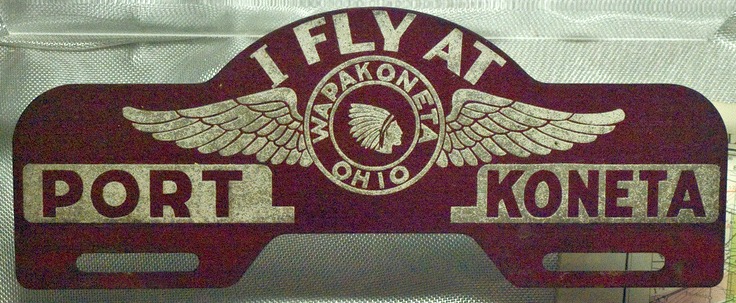
An undated license plate frame, promoting “I fly at Port Koneta”.
Wapakoneta Airport was apparently closed at some point between 1962-69,
as only the new Neil Armstrong Airport (to the southwest) was depicted on the 1969 Chicago Sectional Chart.
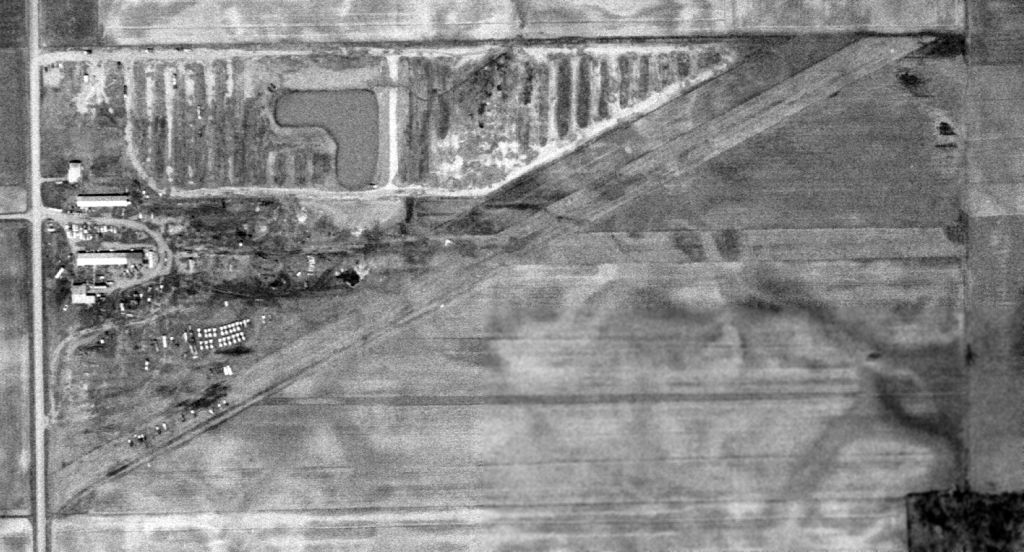
The earliest photo which has been located of the site of Wapakoneta Airport was a 4/16/71 USGS aerial view.
The 3 airport buildings still stood along the west side, and the remnants of the 2 grass runways were still recognizable.
The 1973 USGS topo map still depicted the 3 buildings (hangars?) from Wapakoneta Airport,
but the runways were no longer depicted.
The former runways were no longer discernible on a 1994 USGS aerial photo.
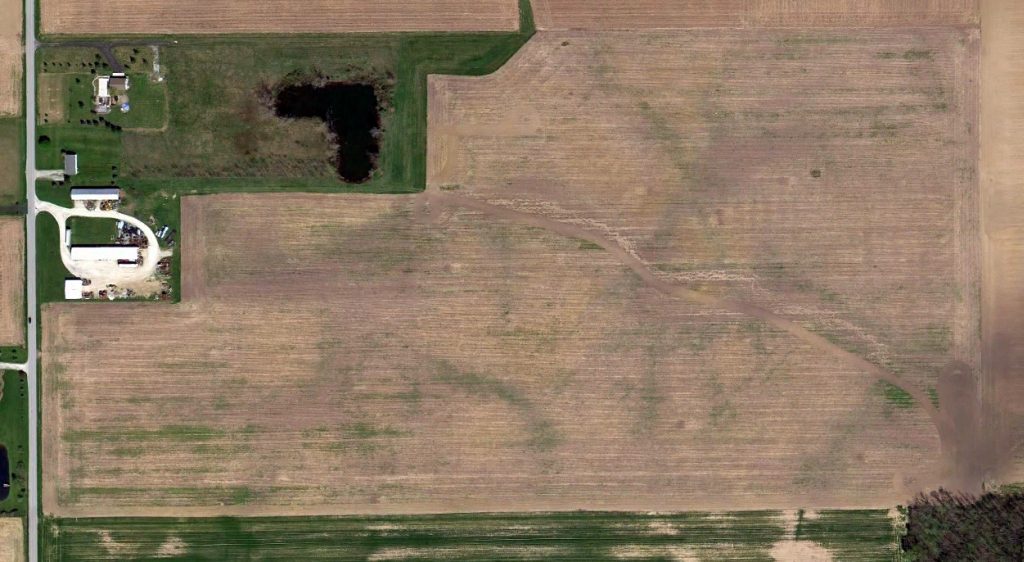
A 4/6/12 aerial photo shows the 3 airport buildings still stood along the west side of the site of Wapakoneta Airport,
with the runway site having been returned to cultivation.
Does the farmer of the property realize this is the hallowed ground where the first man to walk on the moon learned to fly?
The site of Wapakoneta Airport is located southeast of the intersection of Wapakoneta Cridersville Road & Wapakoneta Buckland Road.
Thanks to Jim Hackman for pointing out this airfield.
____________________________________________________
Stickney Avenue Airport, Toledo, OH
41.7, -83.52 (Northwest of Columbus, OH)
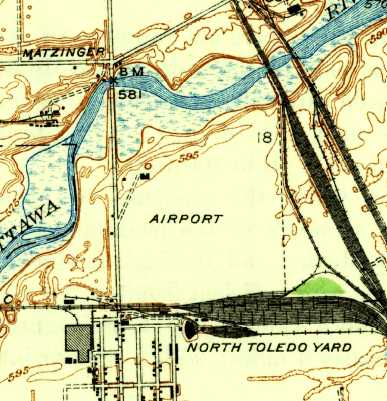
Stickey Avenue Airport, as depicted on the 1938 USGS topo map (courtesy of Don Reed).
Photo of the airport has not been located.
According to the Toledo City Paper, Stickney Avenue Airport opened in October 1927.
They wrote, “1928: Due to poor planning, Stickney is replaced 8 months later by the more effectively located Toledo Transcontinental Airport.”
However, Stickney Airport continued to operate for years, as it continued to be depicted on aeronautical charts & maps.
The earliest depiction which has been located of Stickney Avenue Airport was on the 1938 USGS topo map (courtesy of Don Reed).
It depicted an open landing area, with 2 small buildings on the northwest side, labeled simply as “Airport”.

The earliest aeronautical chart depiction which has been located of Stickney Avenue Airport was on the March 1940 Cleveland Sectional Chart.
It depicted Stickney Avenue as a commercial/municipal field.
Stickney Avenue Airport was evidently closed at some point between 1940-42,
as it was no longer depicted on the February 1942 Cleveland Sectional Chart (courtesy of Chris Kennedy).
The Stickney Plant, a large factory, was opened in 1942 by auto parts manufacturer Autolite on the site of the Stickney Avenue Airport.
The 1952 USGS topo map showed 2 airport buildings remained depicted on the northwest side of the airport property,
but a large factory had covered the southern portion of the airfield.
A 1963 USGS aerial photo showed an airport building remained on the northwest side of the airport property,
but a large factory had covered the southern portion of the airfield.
The 1968 USGS topo map showed a 2nd large building had been added on the south side of the property between 1954-68.
Amazingly, the 2 airport buildings were still depicted on the northwest side of the airport site on the 1980 USGS topo map.
In 1981, the Stickney Plant was converted for vehicle production, building the Jeep Grand Wagoneer.
The 2 former airport buildings were no longer depicted on the 1993 USGS aerial photo
(the earliest photo which has been located of the airport property).
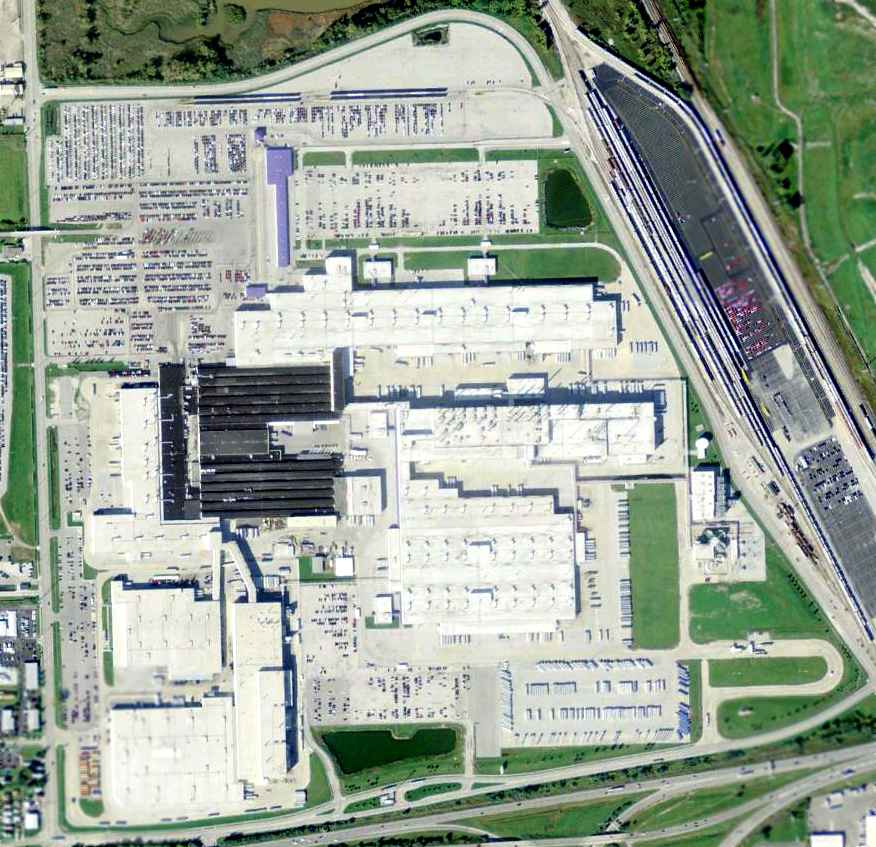
A 10/28/11 aerial view showed no trace of the former Stickney Avenue Airport, now covered by a massive truck factory.
As of 2012, the site of Stickney Avenue Airport is the location of the Toledo Supplier Park, which produces the Jeep Wrangler.
The site of Stickney Avenue Airport is located northeast of the intersection of Stickney Avenue & Interstate 75.
Thanks to Don Reed for pointing out this airfield.
____________________________________________________
41.7 North / 83.64 West (Northwest of Columbus, OH)
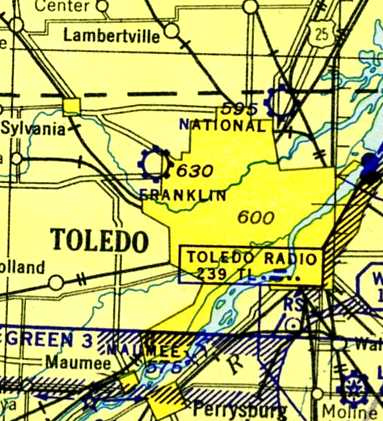
Franklin Airport, as depicted on the February 1942 Cleveland Sectional Chart (courtesy of Chris Kennedy).
According to an article in the 6/26/52 Toledo Blade (courtesy of Phil Alloy), Franklin Airport opened in 1939.
However, Franklin Airport was not yet depicted on the 1940 March Cleveland Sectional Chart (courtesy of Richard Finley).
George Ritter recalled, “'At the Franklin Airport on 7/2/40, this was my first flight at the age of 3 & it was in a 1939 Stinson 105, maroon low-power 3-place bird.
The airport was a large grass field with no runway depiction.
Franklin Flight Service was an unknown and later (a year or so) got combined to National Flight Service.”
The earliest depiction which has been located of Franklin Airport
was on the February 1942 Cleveland Sectional Chart (courtesy of Chris Kennedy).
It depicted Franklin as a commercial/municipal airfield.
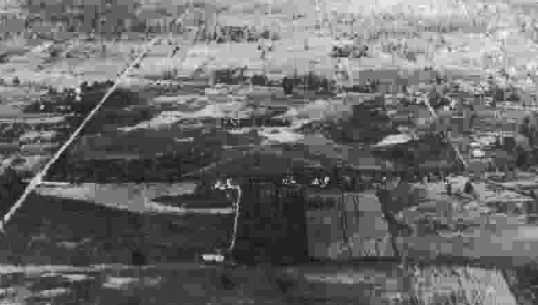
The earliest dated photo which has been located of Franklin Airport
was a 10/10/43 aerial view looking north from the 1945 AAF Airfield Directory (courtesy of Scott Murdock).
It depicted Franklin Airport as an open unpaved landing area.
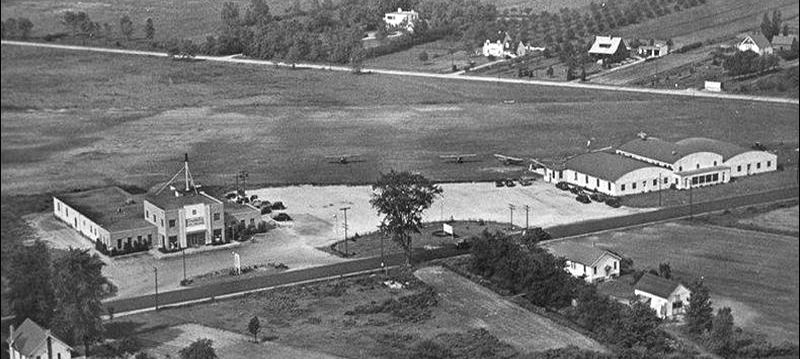
A circa early 1940s aerial view looking at the buildings of the Franklin Ice Cream Company & the hangars of Franklin Airport along Monroe Street (courtesy of Don Reed)
showed at least 3 single-engine aircraft on the grass airfield.
Don Reed recalled that he learned to fly at Franklin Airport in 1944.
According to Don, “My instructor was a World War ! pilot that could preform a ballet with a J3 Cub.
I was to young to drive so I would hitchhike to the airport.”
The 1945 AAF Airfield Directory (courtesy of Scott Murdock) described Franklin Airport
as a 104 acre irregularly-shaped field having 3 sod runways, the longest being a 3,000' northwest/southeast strip.
The field was said to have 3 concrete block hangars, the largest measuring 90' x 51'.
Franklin Airport was was described as being owned & operated by private interests.
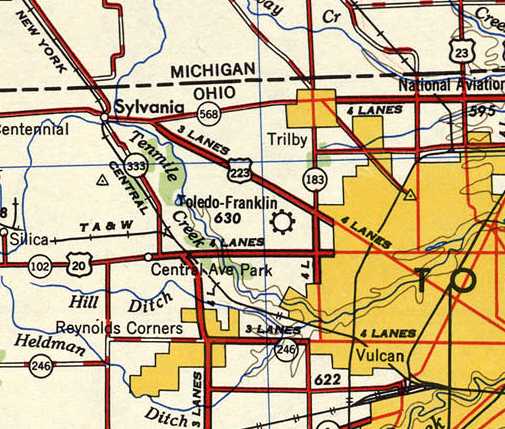
The earliest topo map depiction which has been located of Franklin Airport was on the 1948 USGS topo map.
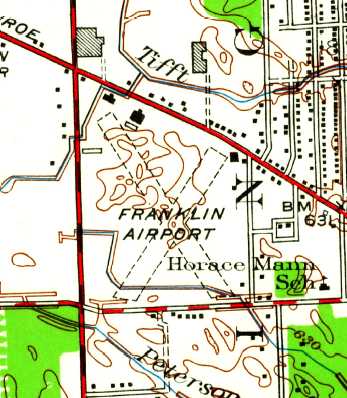
The last depiction which has been located of Franklin Airport was on the 1951 USGS topo map.
It depicted Franklin as having 2 unpaved runways in an X-shape, with several buildings on the northwest & northeast sides.
An article entitled “Franklin Airport Slated to Close on Sep. 15” appeared in the 6/26/52 Toledo Blade (courtesy of Phil Alloy).
It described the field as a 104 acre site, with 3 sod runways, 1 T-hangar & 3 cinderblock buildings.
Franklin Airport was no longer depicted on the 1958 USGS topo map.
According to Phil Alloy, “I grew up in Toledo. Franklin Field... in the 1960s the control tower was still standing having been converted to an ice cream store.
The control tower was multi-story so I imagine there was an active field at one time.
By the 1960s the large site was used as a location for radio control model airplane flights.
After the airfield closed the control tower was converted into an ice cream store for the company [Franklin Ice Cream] that owned the air field.”
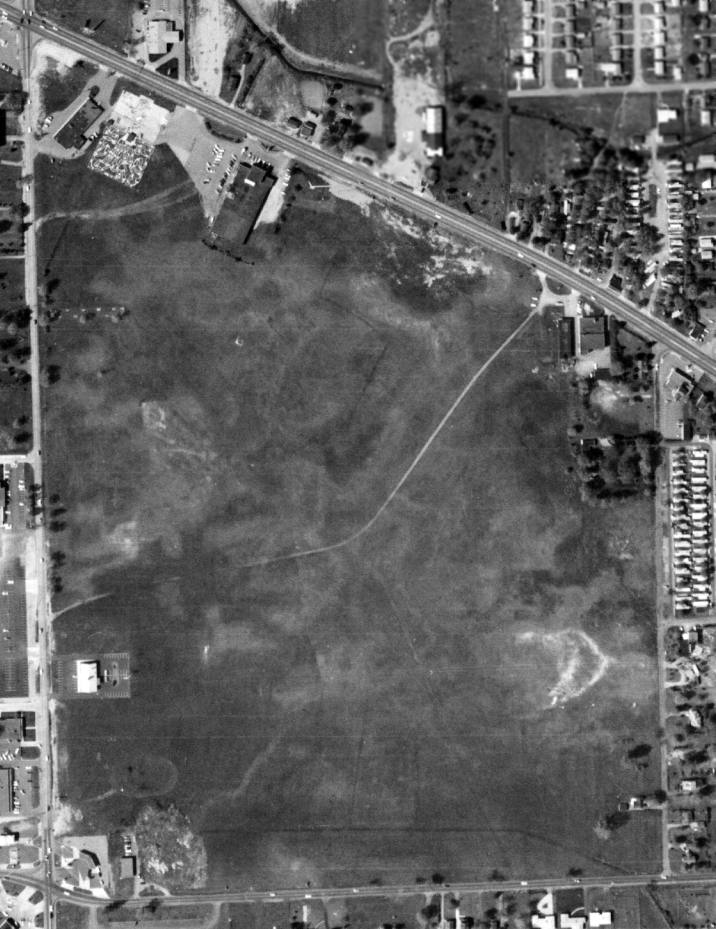
A 5/1/63 USGS aerial photo showed the majority of the airfield site remained clear, although runways were no longer recognizable.
According to Phil Alloy, “The control tower survived well past all the [other] buildings.
It is the one building that stood until the current mall was constructed in the 1970s.
Due to the growth of the city into the west suburbs the property became increasingly valuable for development.
In the 1970s the site was used for a mall [originally called 'Franklin Park Mall', it is now renamed as 'Westfield Mall'].
No trace of the original airfield exists.”
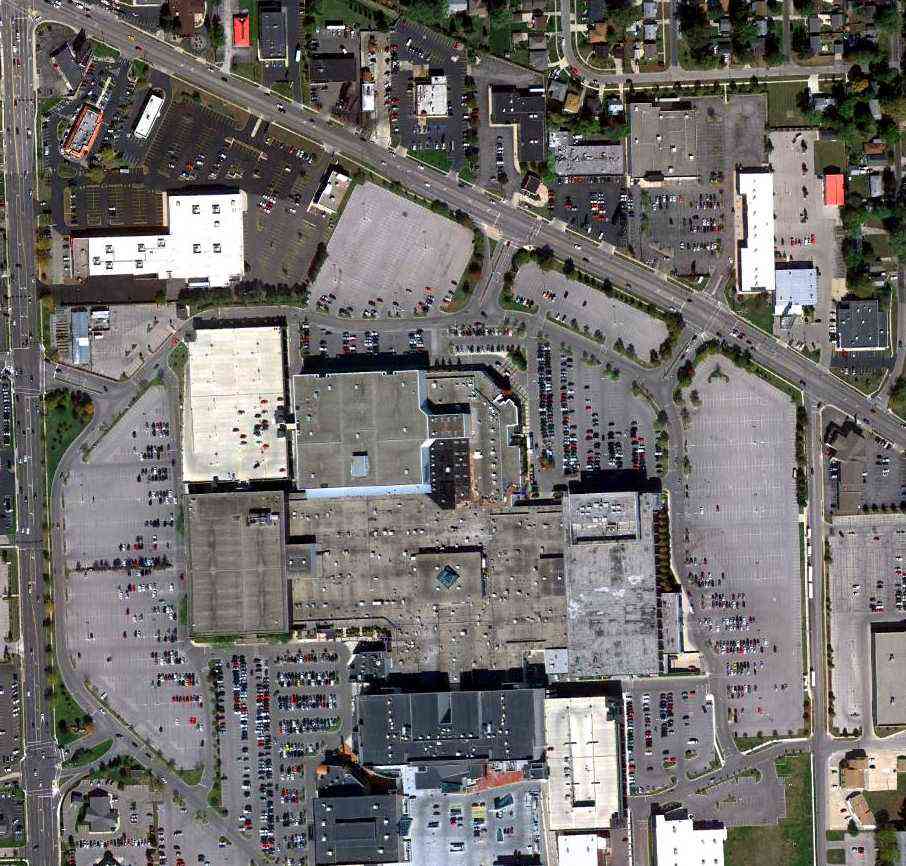
A 10/7/10 aerial view of the site of Franklin Airport, now the location of Westfield Mall.
The site of Franklin Airport is located southeast of the intersection of Monroe Street & Tallmadge Road.
____________________________________________________
National Aviation Airport / National Airport, Toledo, OH
41.72 North / 83.54 West (Northwest of Columbus, OH)
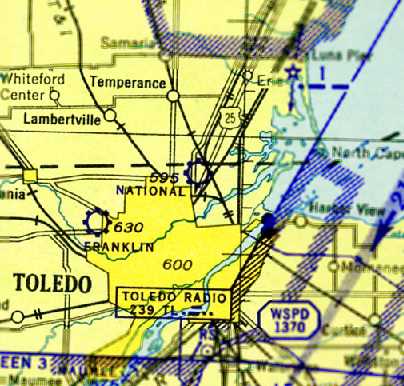
National Airport, as depicted on the February 1942 Cleveland Sectional Chart (courtesy of Chris Kennedy).
This general aviation airport was evidently established at some point between 1935-42,
as it was not yet depicted on the 1935 Regional Aeronautical Chart.
The earliest depiction which has been located of National Airport
was on the February 1942 Cleveland Sectional Chart (courtesy of Chris Kennedy).
It depicted National as a commercial/municipal airfield.

The earliest photo which has been located of National Aviation Airport
was a 10/10/43 aerial view looking north from the 1945 AAF Airfield Directory (courtesy of Scott Murdock).
It depicted National Aviation Airport as having 3 grass runways.
The 1945 AAF Airfield Directory (courtesy of Scott Murdock) described the National Aviation Airport
as a 165 acre irregularly-shaped field having 3 loam & sod runways, the longest being a 3,800' northeast/southwest strip.
The field was said to have 2 concrete block hangars, the largest measuring 120' x 80'.
National Aviation Airport was was described as being owned & operated by private interests.
The 1945 Haire Publishing Company Airport Directory (courtesy of Chris Kennedy)
described “National Aviation Airport” as a “class 3” airfield, owned & operated by National Aviation Corporation.
The manager was listed as W.J. Thompson.
The field was said to have 3 sandy & loam runways, with the longest being the 3,800' northeast/southwest strip.
The field was said to have 2 hangars.

National Aviation Airport, as depicted on the 1948 USGS topo map.
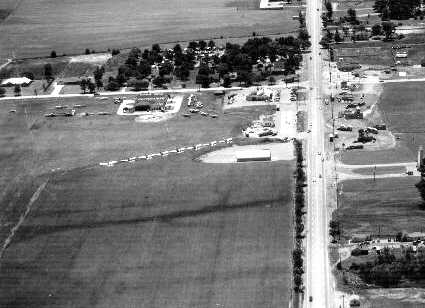
A circa 1950 aerial view looking south at National Aviation Airport (from the Toledo Lucas County Public Library, courtesy of Brian Nelson).
It depicted the field as having a grass airfield area, with several hangars on the southwest side,
and a large number of light aircraft.
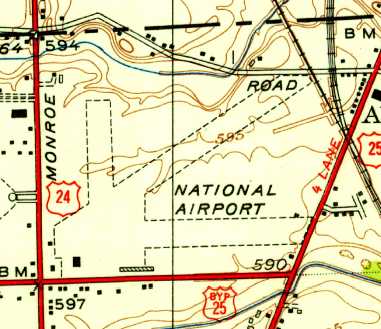
The 1952 USGS topo map depicted National Airport as having 3 unpaved runways,
with a ramp & hangars at the southwest corner.

The 1953 OH Airport Directory (courtesy of Hank Lehrer)
depicted National Aviation Airport as having 3 runways, including a 3,800' northeast/southwest unpaved runway
and a 2,950' east/west cinder runway.
Several hangars were depicted on the southeast side.
The manager was listed as J.E. Akin.
Tgsaul recalled, “National Airport... I learned to fly there from Aiken Aircraft Corporation starting in 1954,
and later becoming a commercial pilot & flight instructor for John Aiken.”
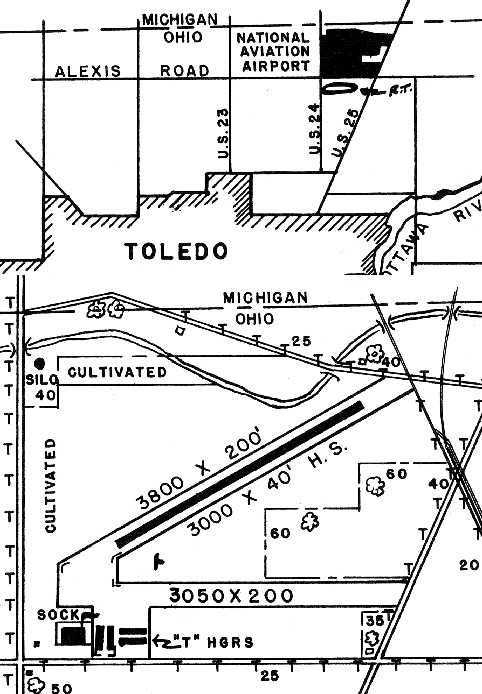
National Aviation Airport gained a paved runway at some point between 1953-61,
as the 1961 OH Airport Directory (courtesy of Hank Lehrer)
depicted National Airport as having 2 runways, including a 3,800' northeast/southwest runway within which was a 3,000' paved section.
Several hangars were depicted on the southeast side.
The manager was listed as Richard Macauley.
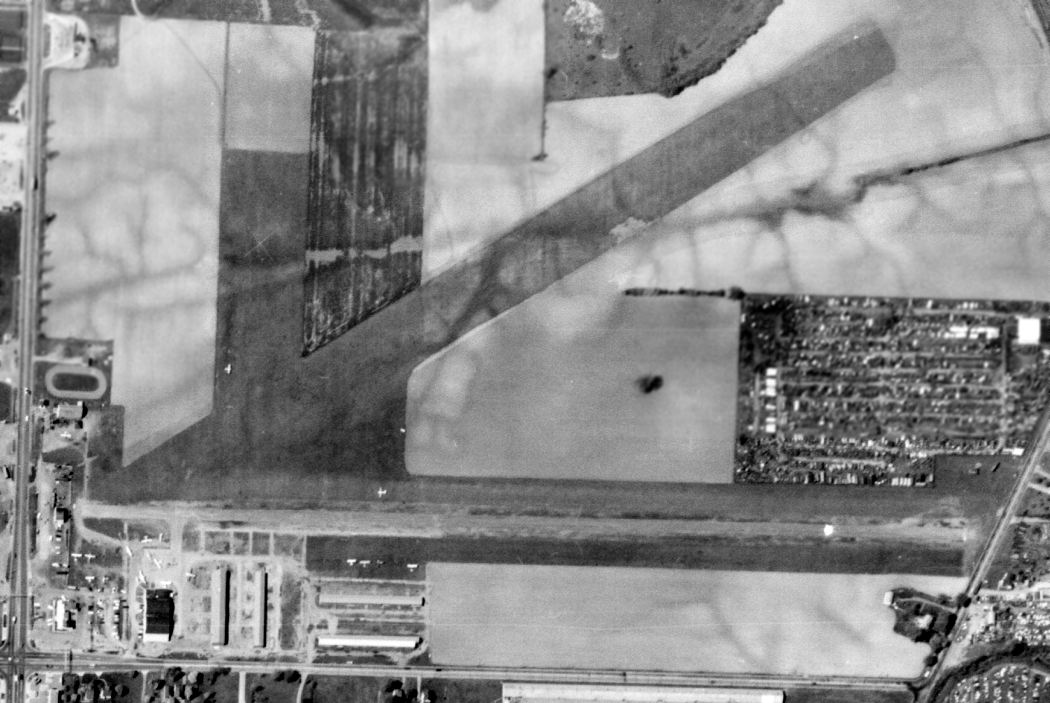
A 5/6/63 USGS aerial photo showed National Airport having 3 runways, and over a dozen single-engine aircraft parked on the southwest side.
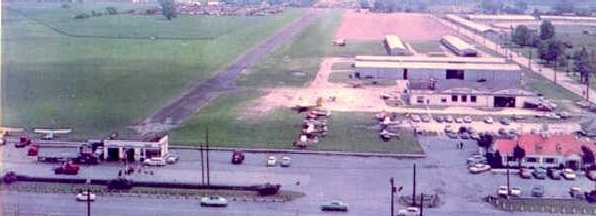
An undated (circa pre-1965) aerial view looking east at National Airport (courtesy of Tom McClain).
The airport had a single asphalt east/west runway, with several hangars on the south side of the field.
The airport appeared well-used, with several single-engine aircraft parked on the field.
Note the building which appeared to be directly at the west end of the runway.
According to Hans Friedebach, “National Airport... During the 1960s it was the home base & operated by National Flightservices Inc.”
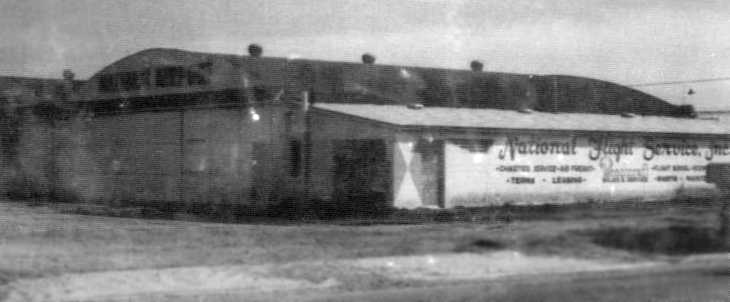
A circa 1965 photo of the National Flight Service Inc. hangar at National Airport (from the Toledo Lucas County Public Library).
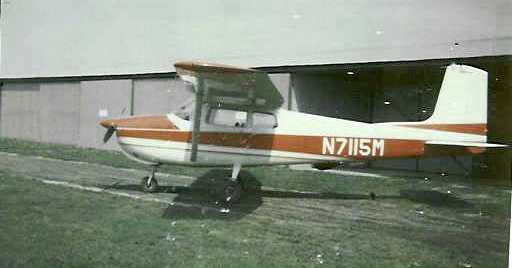
A circa 1965 photo by Don Reed of his Cessna 175, N7115M, in front of a National Airport hangar.
Roger Johnson recalled of National Airport, “As a kid in the 1960s growing up on the north side of Toledo,
an east wind would have private planes approaching subject airport right over my parent's house.”
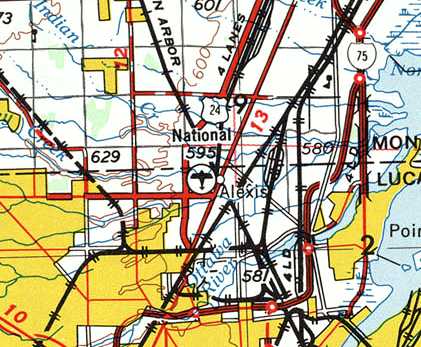
The 1969 USGS topo map still depicted National Airport.
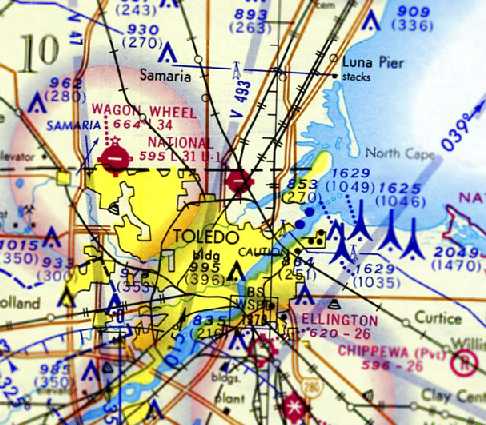
The last aeronautical chart depiction which has been located of National Airport
was on the May 1971 Detroit Sectional Chart (courtesy of Chris Kennedy).
It depicted National as having a single 3,100' paved east/west runway.
According to Tom McClain, National Airport was “closed sometime in the early 1970s.
I remember it a an open field where people would fly their radio-controlled planes.”
According to Hans Friedebach, “National was closed sometime around the early 1970s since it could not support itself financially.
It was developed as a shopping center site without a trace of the former airport.”
John Arnold was evidently the last person to land & takeoff at National Airport.
He recalled, “My logbook shows this to have been 7/13/76.
I landed there dead stick in a Piper Arrow on a flight from Alabama to Monroe, MI.
I had run out of gas & had to have some brought to me from Wagon Wheel Airport.
The airport was closed & there were some barrels on the paved runway where kids had bonfires at night.
Wagon Wheel personnel brought me 5 gallons of gas & needless to say you can't see it as viewed from the filler port.
I then flew to Wagon Wheel to top the tanks.
I managed to get out of there before the press showed.
A city policeman was there & took me to a payphone to call for gas to be brought from Wagon Wheel Airport.
Airport buildings had been cleared for the construction of the shopping center.”
According to Roger Johnson, “A major regional mall was built on the site of National during the late 1970s,
obliterating every hint of the very active site.”
By the time of the December 1976 CF-18 World Aeronautical Chart (courtesy of Chris Kennedy),
National Airport was depicted as an abandoned airfield.
Tom McClain recalled of National Airport, “I'm pretty sure that some time in the 1980s
a small plane was forced to use the field in an emergency landing.”
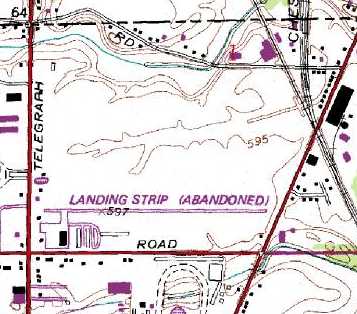
The 1981 USGS topo map still depicted the east/west paved runway at National Airport,
as well as the taxiways, ramp, and hangars at the southwest corner.
The property was labeled as “Landing Strip (Abandoned)”.
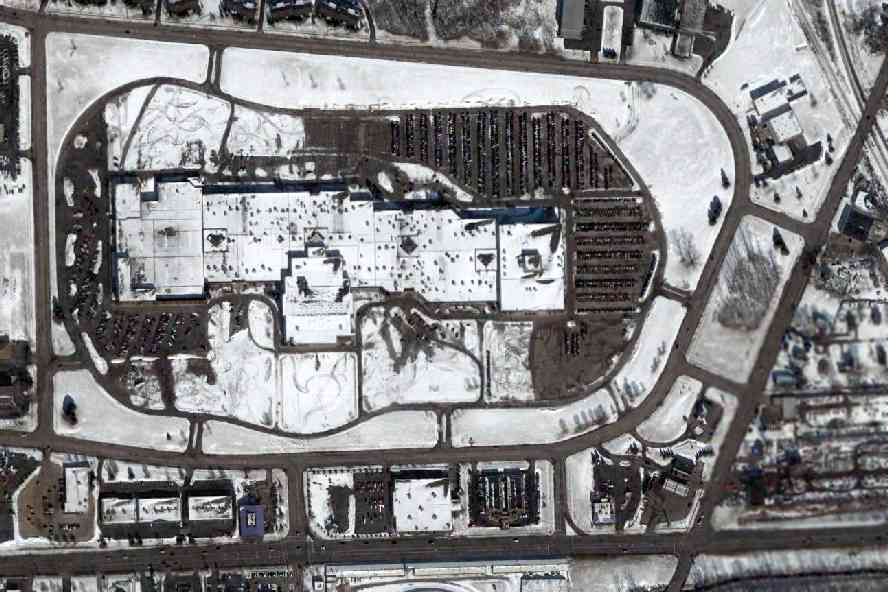
A February 2005 aerial photo showed the mall covering the site, with no trace visible of the former National Airport.
Roger Johnson reported in 2008, “NorthTowne Mall didn't remain viable very long, and while the buildings remain, there is little or no activity
and the parking lots are used for vehicle staging by Chrysler's Jeep plant nearby.”
The site of National Airport is located northwest of the intersection of North Detroit Avenue & East Alexis Road.
____________________________________________________
Lima Airport / Allen County Airport (LIA), Lima, OH
40.76 North / 84.18 West (Northwest of Columbus, OH)

Lima Airport, as depicted on a 1936-37 Chicago Sectional Chart (courtesy of Chris Kennedy).
According to the website of WTLW 44, the Allen County Airport was built in 1933.
The earliest directory listing of the field which has been located
was in the 1934 Department of Commerce Airport Directory (courtesy of Chris Kennedy).
It described Lima as a Municipal Airport, located three miles northwest of the town of Lima.
The airfield was said to consist of three sod runways,
with the longest being a 2,640' northeast/southwest strip.
A hangar was said to be located in the northwest corner.
The Airport Directory Company's 1937 Airports Directory (courtesy of Bob Rambo)
described Lima as having 3 sod runways, with the longest being the 3,960' east/west strip.
A hangar on the west side was said to have "Lima" painted on the roof.
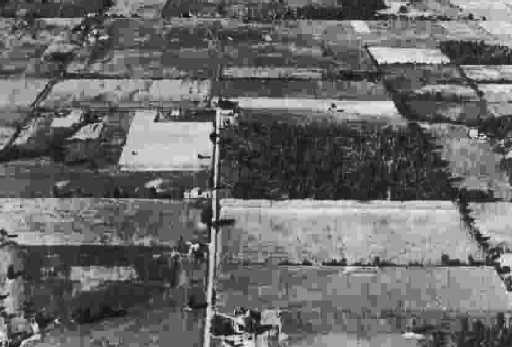
The only photo which has been located showing Lima Municipal Airport while in operation
was a 9/28/43 aerial view looking north from the 1945 AAF Airfield Directory (courtesy of Scott Murdock).
It depicted the field as being an open grass area.
The 1944 US Army/Navy Directory of Airfields (courtesy of Ken Mercer)
described Lima Airport as having a 4,200' unpaved runway.
The 1945 AAF Airfield Directory (courtesy of Scott Murdock) described the Lima Municipal Airport
as a 144 acre L-shaped field having 2 sod runways, the longest being a 4,200' east/west strip (described as “rough”).
The field was said to have 3 concrete & steel hangars, the largest measuring 75' x 60'.
Lima Municipal Airport was was described as being owned & operated by private interests.
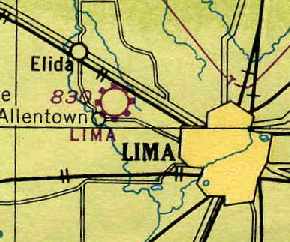
Lima Airport, as depicted on the June 1946 Chicago Sectional Chart (courtesy of Chris Kennedy).
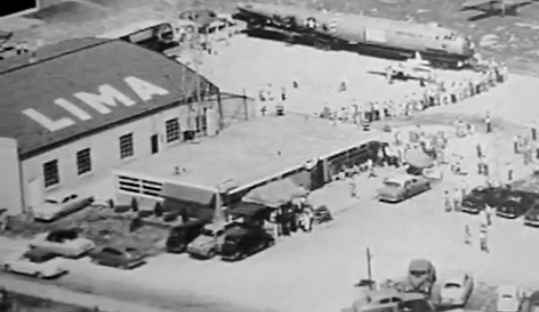
A circa 1940s-50s aerial view of Lima Airport, presumably during some kind of display – note the B-29 bomber fuselage.
According to the website of WTLW 44,
the golden years for the Allen County Airport were 1953-63,
when Lake Central Airlines ran DC-3 service to Pittsburgh, Cincinnati and Columbus.
Starting on the June 1960 Chicago Sectional Chart (courtesy of Chris Kennedy)
the field was labeled as the Allen County Airport.
It had also gained a paved runway, as it was depicted as having a single 3,500' paved runway.
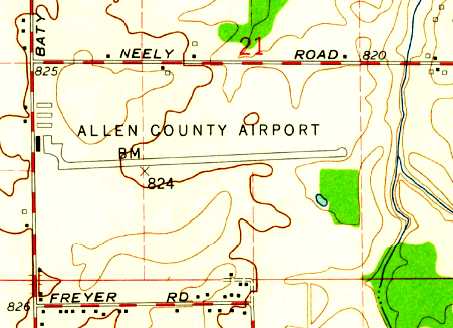
The 1960 USGS topo map depicted Allen County Airport as having a single paved east/west runway,
with a ramp & 4 buildings on the west side.
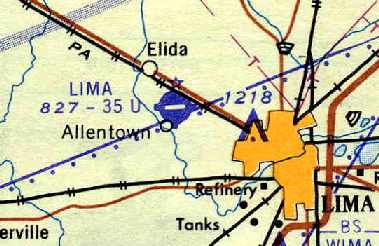
By the next year, the Lima Airport had apparently reverted to its previous name,
as depicted on the December 1961 Chicago Sectional Chart (courtesy of Chris Kennedy).
A newer airport was built on the east side of Lima in 1963, but the original airport continued in operation.

The 1966 OH Airport Directory (courtesy of Chris Kennedy) depicted Lima as having a single 3,500' bituminous east/west runway,
with a parallel 2,600' sod runway on the north side of the paved runway, and a 2,640' sod north/south runway.
A total of four hangars were depicted on the northwest side of the field. The manager was listed as Walt Plezia.
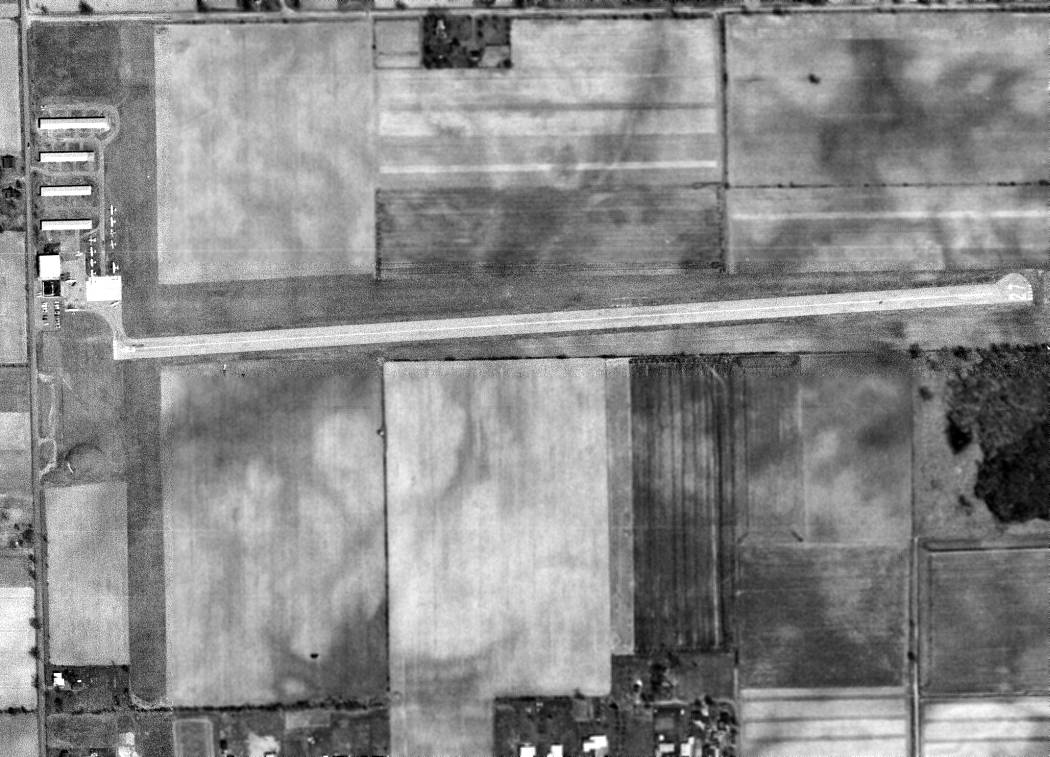
The last photo which has been located showing the Lima Airport in operation was a 4/16/71 USGS aerial view.
It showed Lima as having a paved Runway 9/27 & a grass crosswind runway.
A dozen single-engine aircraft were visible parked around the hangars on the west side.

The 1972 Flight Guide (courtesy of Chris Kennedy) showed that Lima had gained an NDB navigational beacon on the field.
The runway configuration had not changed.
The Lima Airport's status had changed at some point between 1972-76 to a private field,
as that is how it was described in the 1976 AOPA Airport Directory (courtesy of Chris Kennedy).
By 1977, the USGS topo map depicted that a new Allen County Airport had been constructed,
five miles southeast of the town of Lima.
The original Lima Airport was apparently closed at some point between 1976-80.

An undated photo of the former hangar (courtesy of John Sams), with the words “Aviation Corporation” still visible,
during the hangars conversion into a TV studio.
According to the website of WTLW 44, after the closure of the airport,
“Ron Mighell toured the large 80' x 80' hangar and envisioned it as the largest television studio in Northwest Ohio.
In 1980, scores of volunteers pooled their talents to renovate the dilapidated building into a modern television production facility.”
The original Lima Airport was no longer listed at all in the 1982 AOPA Airport Directory (courtesy of Ed Drury).
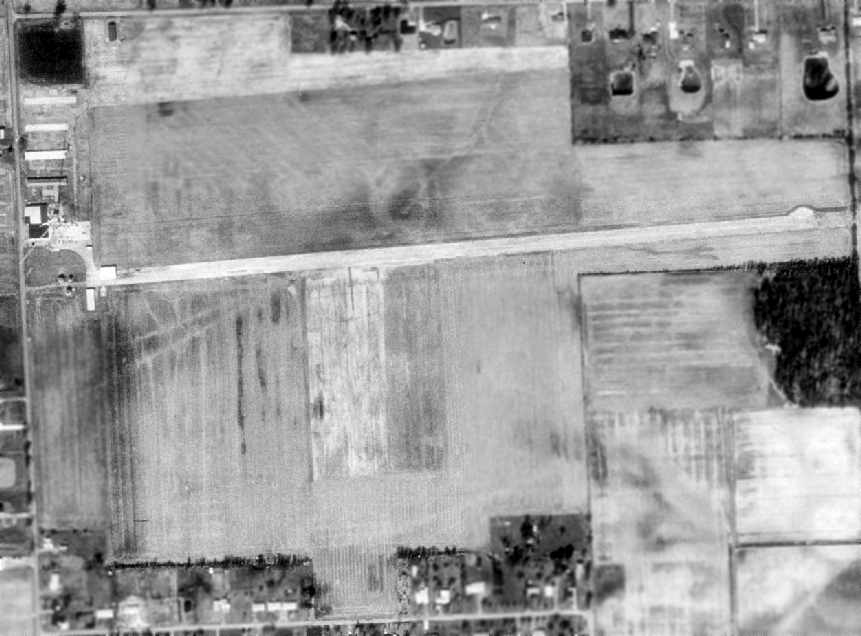
In the 1988 USGS aerial photo, the former Lima Airport appeared to remain largely intact,
with the runways & most of the hangars appearing to remain completely untouched.
The TV transmitter tower could be seen just northwest of the west end of the runway.
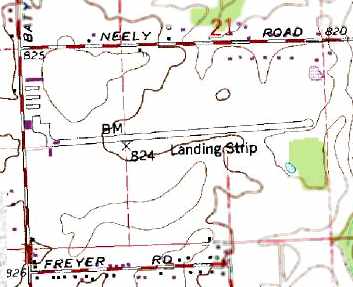
The 1994 USGS topo map depicted a single paved east/west runway,
labeled simply as “Landing Strip”, along with several hangars on the west side of the field.
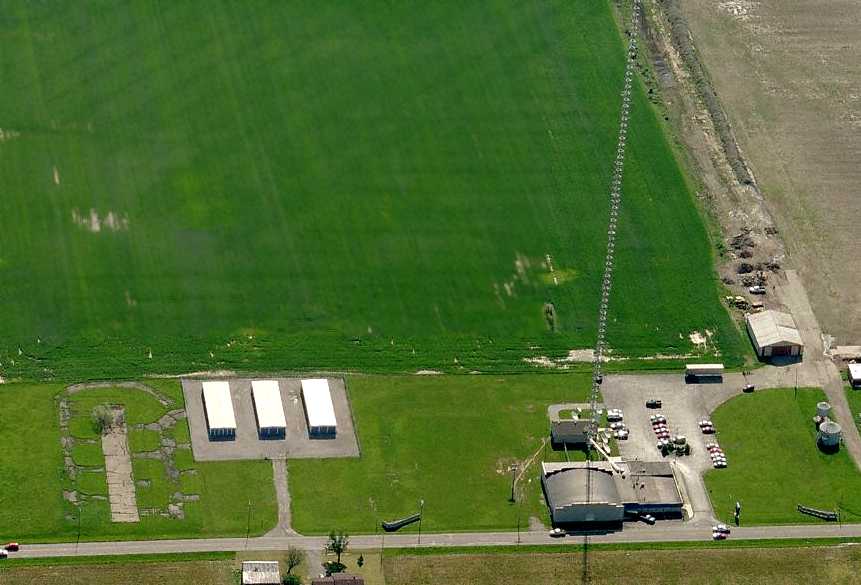
A circa 2007 aerial view looking east at the site of the former Lima Airport showed (from the left) the pavement from the former 3 t-hangars,
the former hangar, the TV transmitter tower, and the remains of the paved runway.
John Sams reported in 2007, “The old main hangar is now the main studio / office for the local Christian TV station 44.
Nothing appears to remain of the old runway except the clearing [however the runway appears to remain intact in the 2006 photo].
The small hangars to the north of the main are only slabs foundations.
The main transmission tower for the TV station
(which appears on the current Detroit Sectional as a lighted obstruction of 1,532' MSL to the northwest of the city)
appears to be sitting right at the start of Runway 9.
New houses are being built close to the east side of the old runway clearing.
It will not be long & they will be on the old runway site.”
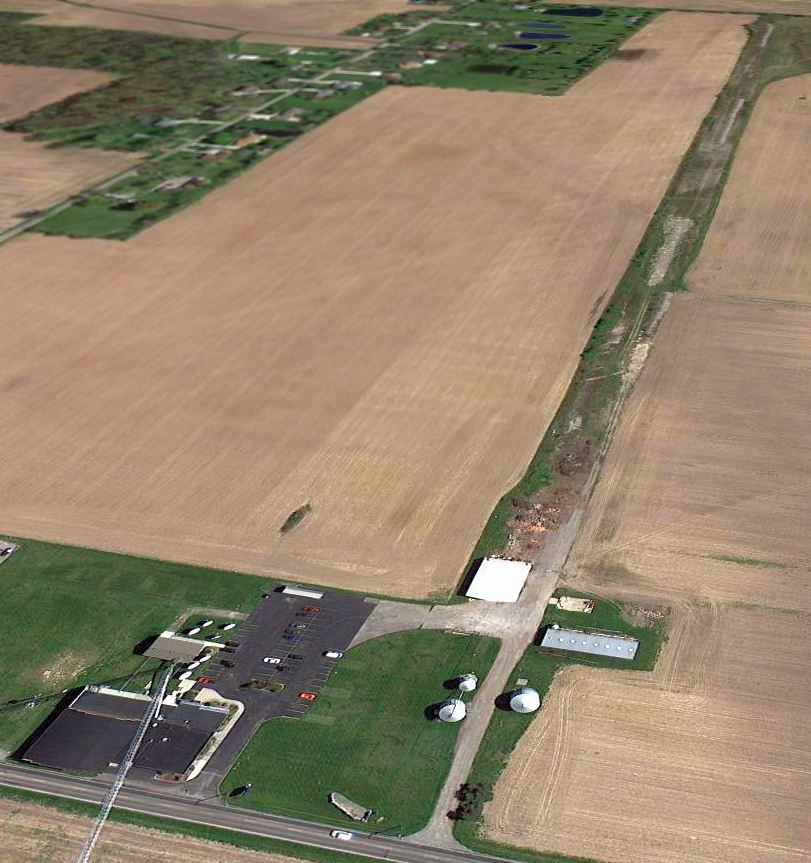
A 4/6/12 aerial view looking northeast showed the former Lima Airport appeared to remain largely intact,
with the runways & some of the hangars appearing to remain completely untouched.
The site of Lima Airport is located southeast of the intersection of Neely Road & Baty Road.
____________________________________________________
Camp Perry National Guard Airfields #1 & #2, Camp Perry, OH
41.55, -83.04 (West of Cleveland, OH)
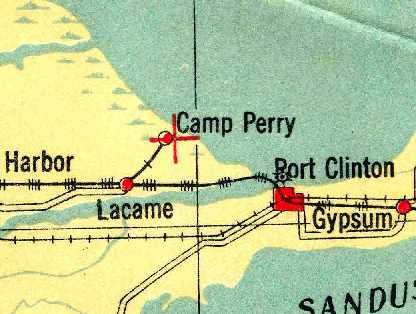
Camp Perry was depicted as an auxiliary airfield on the 1928 Air Navigation Map (courtesy of Chris Kennedy).
The state legislature authorized the purchase of 300 acres of land at what would become Camp Perry in 1906,
to establish a rifle range for the state militia.
The date of construction of the first airfield at Camp Perry has not been determined.
Historical accounts of the Camp do not mention anything about an airfield.
The earliest depiction of the Camp Perry Airfield which has been located
was on the 1928 Air Navigation Map (courtesy of Chris Kennedy).
It depicted Camp Perry as an auxiliary airfield.
An article in the 5/21/32 issue of the Sandusky Star Journal (courtesy of Tom Kowalczk) described the “new” Camp Perry Airfield:
“The new airfield which is being made at Camp Perry for the Ohio National Guard maneuvers,
was Inspected by Adjutant General Frank Henderson; Assistant Adjutant General Lt. Col. John Volka,
and Capt. Fred Smith, Director of Aeronautics of the State, who came to the camp yesterday afternoon by airplane from Columbus,
and Major Errol Zlstel, Commander of the 112th Observation Squadron, who also came by plane from Cleveland.
The new field, which is to the west of the Camp Perry grounds, contains more than 100 acres,
and will replace the present field which is used along the firing line & ranges of the camp.
The new field will eliminate the Interference of the training activities on the old field, when national matches or camp training maneuvers were being held.
This new field will also be used as an emergency field for other air traffic.”
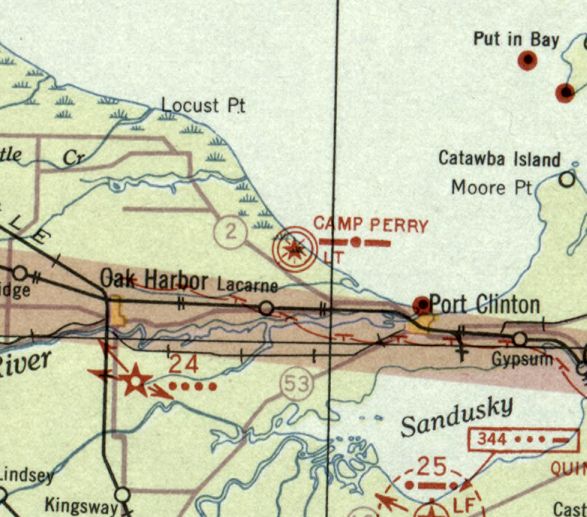
"Camp Perry" was depicted as a military airfield on the December 1932 Cleveland Sectional Chart.
The 1934 Department of Commerce Airport Directory (courtesy of Chris Kennedy)
listed 2 airfields at Camp Perry, both under the title of "Camp Perry Field, National Guard".
The first field was described as being located "at the Camp Perry Rifle Range",
and was described as having two sod landing strips, forming an "L" shape, of 4,000' & 3,000'.
The second field was described as being located "One-half mile west of Camp Perry",
and was described as being an irregularly-shaped sod field, measuring 2,508' x 3,163'.
The 1935 9M Night Flying Chart depicted "Camp Perry Rifle Range" as a military airfield.
An aerial photo of the Camp Perry #1 & #2 Airfields,
from The Airport Directory Company's 1937 Airports Directory (courtesy of Bob Rambo).
The directory described the "Camp Perry (#1) Rifle Range Field" as being located on the east side of the Camp,
and the "Camp Perry (#2) Camp Perry Airport" on the west side of the Camp.
Both fields were otherwise described in the same manner as the 1934 directory.
Major John Kachenmeister recalled, "I used to have some photos of the airfield.
The planes were flown by the 112th Observation Squadron,
and included at least one O-47, and two types of biplanes that I could not identify.
The 112th Observation Squadron was the air reconnaissance element of the 37th Infantry Division, OH National Guard.
The airfield was a sod runway aligned north/south,
with the large building on the east side of the post serving as a maintenance hangar."
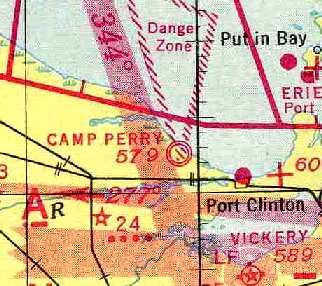
"Camp Perry" was still depicted as an active military airfield
on the 1941 Regional Aeronautical Chart (courtesy of Chris Kennedy).
However, the Camp Perry Airfields apparently were closed at some point between 1941-43,
as no airfields were depicted at the Camp on the April 1943 Cleveland Sectional Chart (according to Chris Kennedy),
the January 1949 Cleveland Sectional Chart (according to Chris Kennedy), or on a 10/1/51 USGS aerial photo.
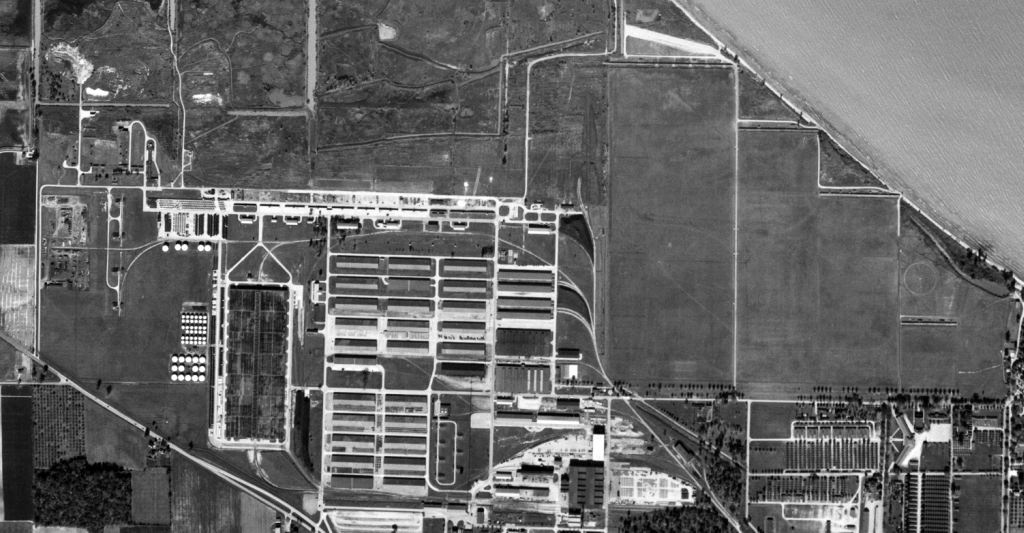
A 10/1/51 USGS aerial photo showed the site of the Camp Perry #1 Airfield on the east side of the Camp
and the "Camp Perry #2 Airfield on the west side of the Camp.
The 1952 USGS topo map seemed to indicate that both fields were closed at that point,
as it did not label the site of the Camp Perry #1 as an airfield of any kind,
and it depicted a large building on the site of the Camp Perry #2 airfield.
Furthermore, it did not depict any other airfields on the Camp property nearby.
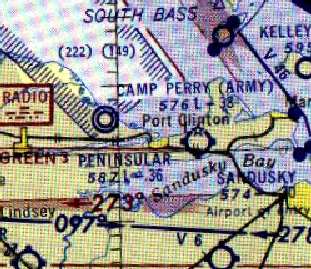
However, apparently one of the two Camp Perry Airfields was reopened at some point between 1943-53,
as the 1953 Flight Chart (courtesy of Scott O'Donnell) depicted "Camp Perry (Army)" as an active airfield,
with a 3,800' unpaved runway.

The July 1956 Cleveland Sectional Chart (courtesy of Chris Kennedy) depicted "Camp Perry (Army)" as an active military airfield.
The Aerodromes table on the chart described the field as having a 3,800 turf all-way landing area,
and the remarks said, "Restricted to official use. Operated by National Guard."
The Camp Perry airfield was closed (again) at some point within the next year,
as it was no longer depicted at all on the January 1957 Cleveland Sectional Chart (according to Chris Kennedy)
or subsequent aeronautical charts.
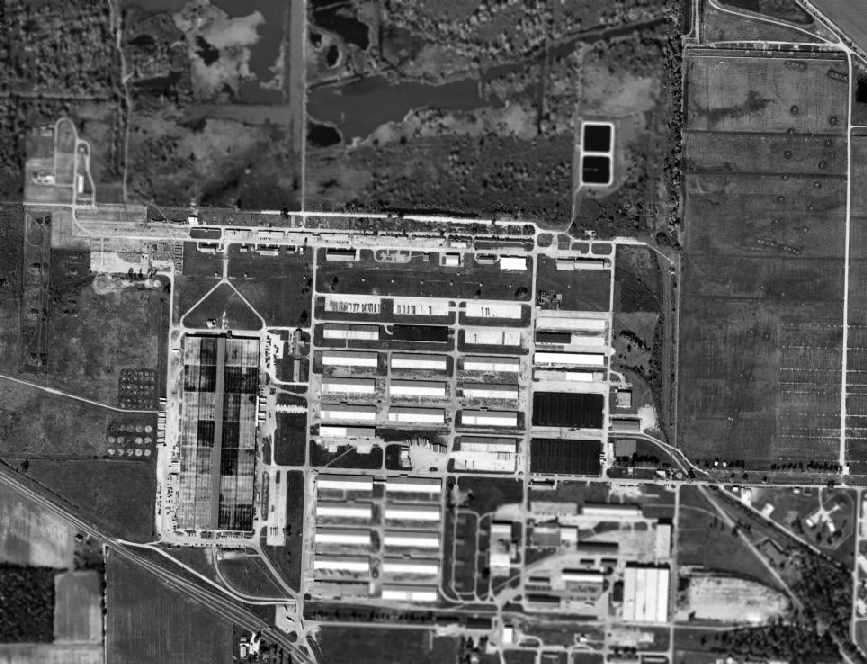
As seen in the 1995 USGS aerial photo,
the property of the Rifle Range #1 Airfield remains undeveloped - presumably still used as a rifle range.
However, a large building still occupies the site of the #2 Airfield, on the west side of the Camp.
Camp Perry continues to operate (as of 2003) as a National Guard training center,
but without an airfield.
Major John Kachenmeister (who was "stationed at Camp Perry off & on since the 1970s") reported in 2005,
"The airfield is still semi-active, as several helicopter pads are installed on what was formerly the runway.
It is not listed on the current sectional charts,
however, upon occasion helicopters are used for dignitary visits or for airmobility training of Guard troops."
The site of the Camp Perry Airfields is located north of the intersection of Route 2 & Avenue K.
____________________________________________________
Bellefontaine Municipal Airport (7I7), Bellefontaine, OH
40.41 North / 83.74 West (Northeast of Dayton, OH)
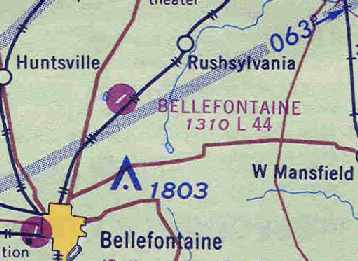
Bellefontaine Airport, as depicted on the May 1968 Cleveland Sectional Chart (courtesy of Chris Kennedy).
This municipal airport was apparently built at some point between 1965-68,
as it was not depicted on a 1959 aerial photo, the 1961 USGS topo map, nor the 1965 Cleveland Sectional Chart (according to Chris Kennedy).
The earliest reference to Bellefontaine Municipal which has been located
was on the May 1968 Cleveland Sectional Chart (courtesy of Chris Kennedy).
It depicted Bellefontaine Airport as having a single 4,400' paved runway.
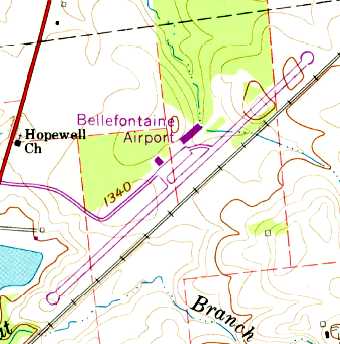
The 1973 USGS topo map depicted Bellefontaine Airport as having a single paved northeast/southwest airport with a ramp & 2 buildings on the northwest side.
The 1976 AOPA Airport Directory (courtesy of Chris Kennedy)
described Bellefontaine Municipal as having a single 4,400' asphalt Runway 4/22,
and said that the field offered hangars, flight instruction, and charters.
The operator was listed as Dynamic Aviation, Inc.
The 1982 AOPA Airport Directory (courtesy of Ed Drury)
described Bellefontaine Municipal as having a single 4,400' asphalt Runway 4/22,
and listed the operator as Brenner Air Service.
Unfortunately, constraints on the growth of the original Municipal Airport would eventually cause its replacement.
The existing airport had a 4,400' runway, with turn-arounds on each end.
The landing thresholds for both runway ends were displaced 200' due to obstructions in the approaches.
Expanding the existing airport to meet forecasted demand would be limited due to existing constraints,
including State Road 68 & a nearby railroad & landfill.
As described in AOPA Online, planning for a replacement airport for the city of Bellefontaine began in the 1980s,
when Robert Lentz, then a city councilman began pushing for a replacement airfield.
The plan originally faced strong opposition, but over time, and with the help of the aviation community,
Lentz won enough support for the project to go ahead.
The community effort continued when a local businessman & area pilot agreed to buy
the current FBO (Midwest Corporate Air) & take over management of the airport for the city.
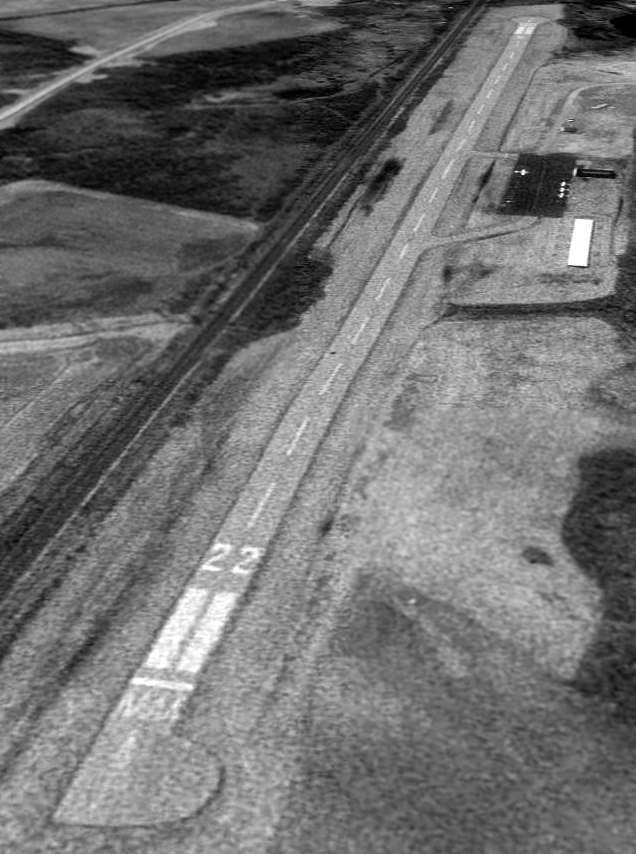
The only photo which has been located showing Bellefontaine Airport while in operation as a 3/21/94 USGS aerial view looking southwest,
which showed 4 single-engine aircraft on its ramp.
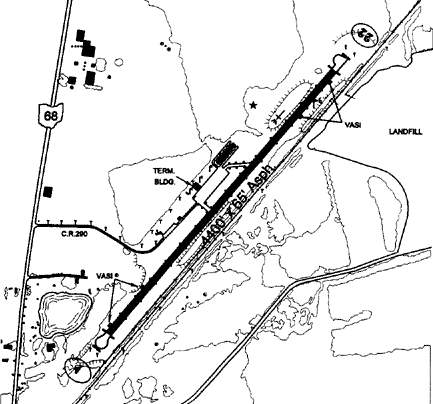
Diagram from the 2001 OH Airport Directory.
In 2002, AOPA President Phil Boyer joined Mayor Robert Lentz & other local dignitaries in Bellefontaine
for the grand opening of the brand-new $13 million Bellefontaine Regional Airport.
It was only the second new airport in Ohio in 30 years.
The new airport is located 4 miles west of the original Municipal Airport,
which was presumably be closed at the same point.
A 2004 aerial view confirmed that the original Bellefontaine Airport had been closed,
as it had closed-runway “X” symbols painted on the runway.
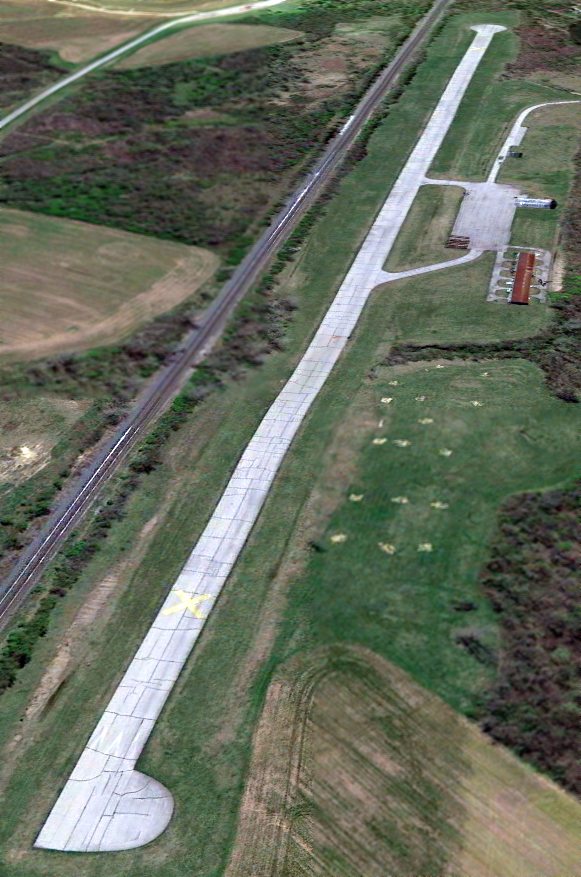
A 4/6/12 aerial view looking southwest showed Bellefontaine Municipal Airport to remain intact.
Bellefontaine Municipal is located southeast of the intersection of Route 68 & Twp Highway 57,
three miles north-northeast of the town of Bellefontaine.
____________________________________________________
Waco Aircraft Company Factory Airfield / Troy-Waco Airport, Troy, OH
40.03 North / 84.22 West (North of Dayton, OH)
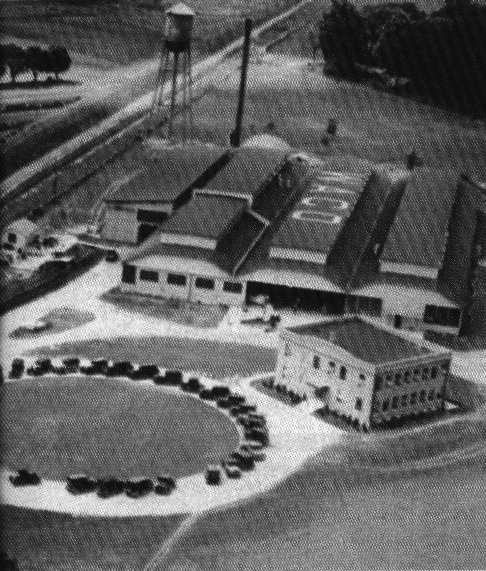
A 1929 aerial view looking southwest at the Waco Troy Factory.
The Waco Aircraft Company came to Troy, OH, in 1923.
Their facility in Troy built a long series of Waco biplanes.
The complex eventually consisted of a factory, a cafeteria building,
and 2 hangars which served as a final assembly building.
The earliest photo which has been located of the Waco complex was a 1929 aerial view,
depicting the factory, with the cafeteria building in front, next to a circular driveway.
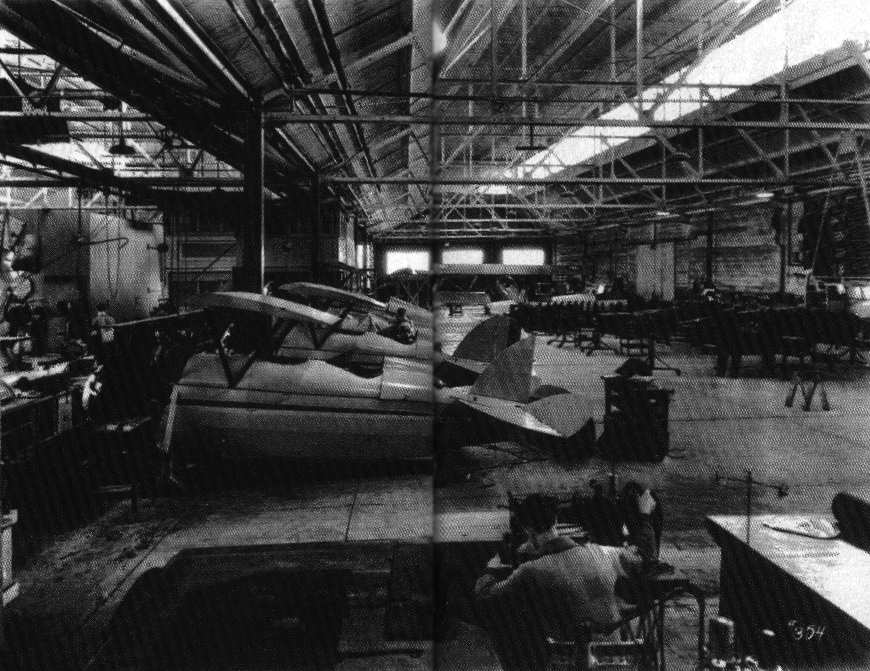
An undated view of the interior of the Waco Troy Factory.

A circa 1930 photo of the Waco Troy factory, showing an aircraft visible inside the door.
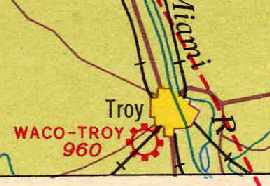
Waco-Troy Airport, as depicted on a 1936-37 Chicago Sectional Chart (courtesy of Chris Kennedy).
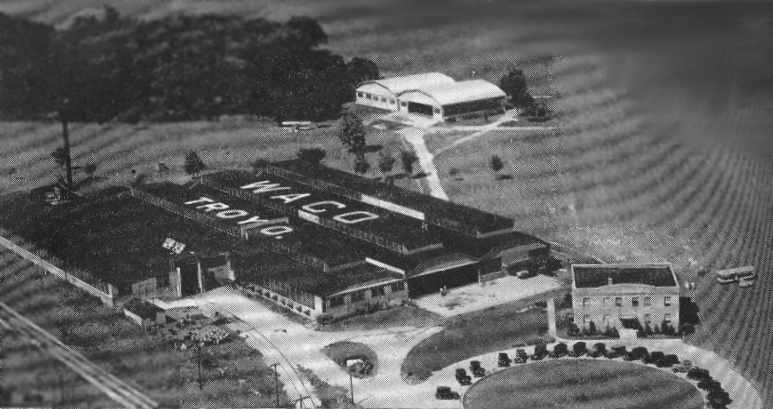
An aerial view looking west from The Airport Directory Company's 1937 Airports Directory (courtesy of Bob Rambo).
It depicted the factory, with the hangars in the background, and the cafeteria building in front, next to the circular driveway.
The directory described the Waco airfield as consisting of a 90 acre sod field.
The Waco factory also built military gliders during WW2.
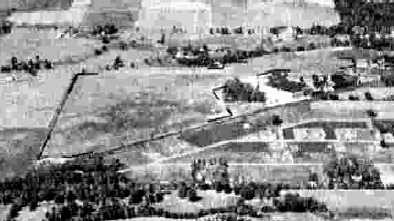
A 9/28/43 aerial view looking north from the 1945 AAF Airfield Directory (courtesy of Scott Murdock)
depicted the “Waco-Troy Airport” as an irregularly-shaped grass field, with the factory on the east side.
The 1944 US Army/Navy Directory of Airfields (courtesy of Ken Mercer)
described the Waco-Troy Airfield as having a 2,900' runway.
The 1945 AAF Airfield Directory (courtesy of Scott Murdock) described the “Waco-Troy Airport”
as a 130 acre L-shaped sod field measuring 2,850' x 2,500'.
The field was said to have 2 hangars, the largest being a 120' x 80' wood & metal structure.
Waco-Troy Airport was was described as being owned & operated by private interests.
After WW2, Waco concentrated on building airplane parts & small machinery due to lower demand but the company continued to make parts for its planes.
The 1946 Chicago Sectional Chart (according to Chris Kennedy) depicted the field as "Waco-Troy".

An undated (circa 1950s?) aerial view looking southeast at the Waco Troy factory.
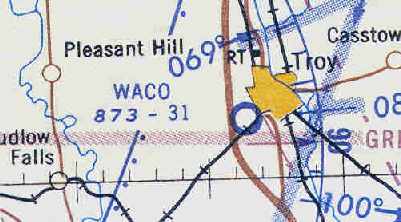
The June 1960 Chicago Sectional Chart (according to Chris Kennedy) still depicted Waco as an active airfield.
The aerodromes table described the field as having a total of 5 runways, with the longest being a 3,100' turf strip,
but also described it as an "all way" landing area.

The last map depiction which has been located of the Troy-Waco Airport was on the 1961 USGS topo map.
It depicted Troy-Waco Airport as an irregularly-shaped outline to the northwest of the factory buildings.
In 1963, Waco founder Clayton Brukner sold his company to Allied Aero Industries Inc. of Syracuse, N.Y,
and the Troy plant was closed soon after.
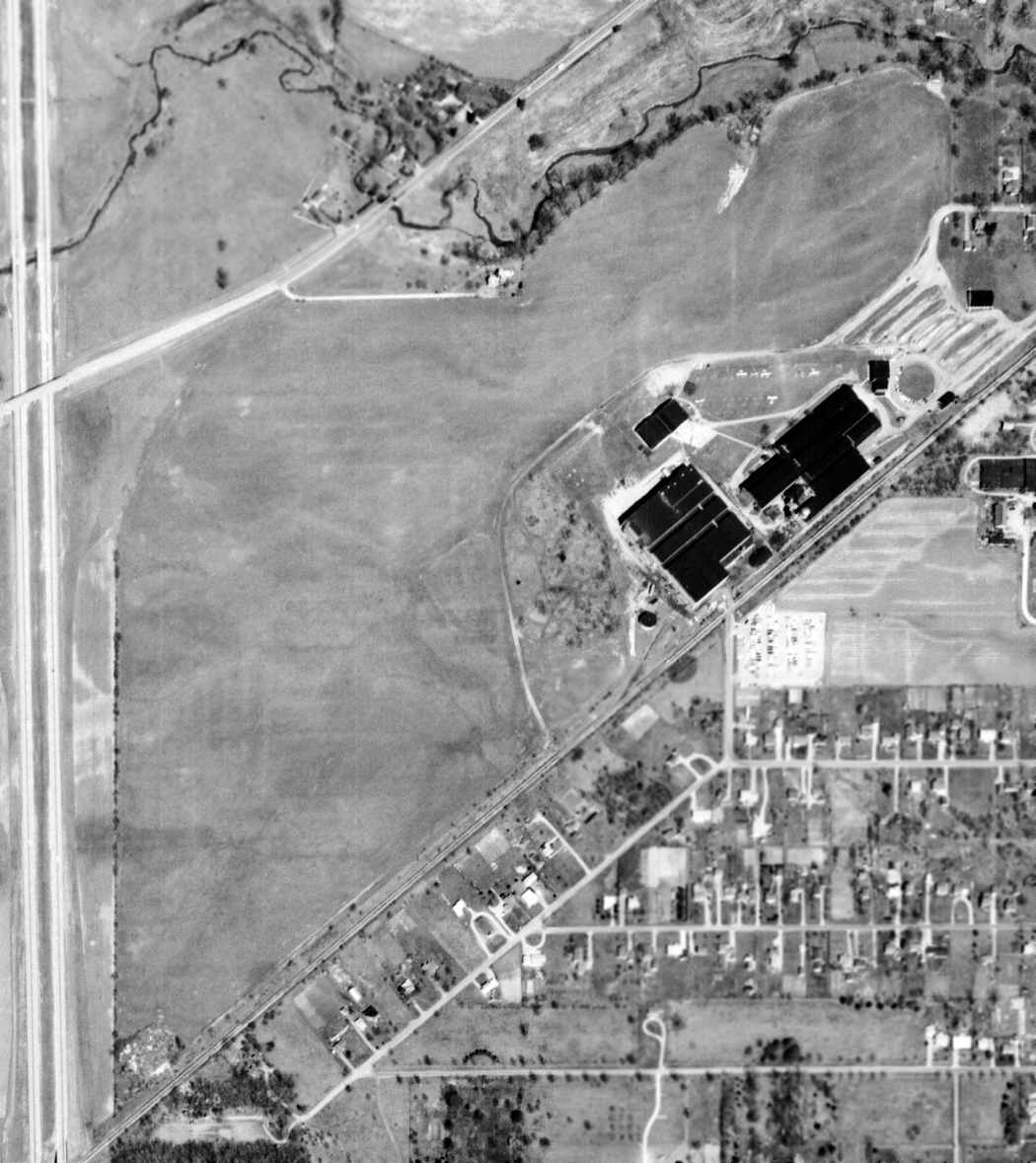
The last depiction which has been located of the Troy-Waco Airport was a 4/15/64 USGS aerial view.
It depicted Troy-Waco Airport as an irregularly-shaped grass field on the northwest side of the factory buildings.
There were 6 single-engine aircraft visible parked near the hangars.
The Waco airfield was evidently closed at some point after 1964, and the runway was built-over in the 1960s.
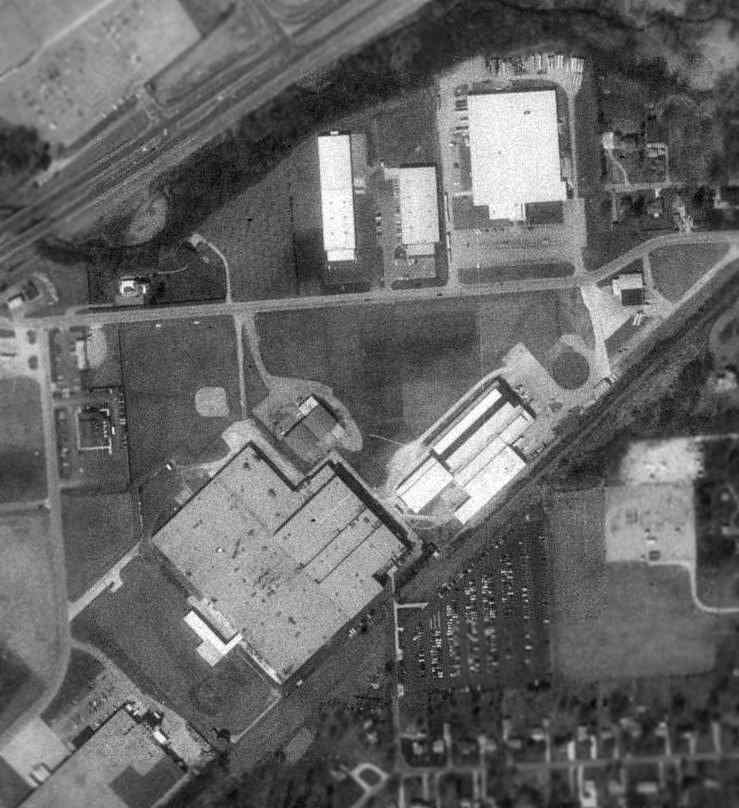
As seen in the 1994 USGS aerial photo,
the original factory with the circular driveway pictured in the 1929 photo is still visible (in the center-right of the 1994 photo).
The hangars still remained as well,
but the cafeteria building adjacent to the driveway had evidently been removed at some point between 1937-94.
As of 2002, the factory was being used as a warehouse.
Amazingly, the equipment used to steam & shrink the fabric onto the Waco airframes
was reportedly still stored up in the rafters of the former factory.
A 2004 aerial view showed that the majority of the circular driveway had been removed at some point between 1994-2004.
A link to aviation remains at the site of the former Waco factory,
as the Goodrich Corporation Aircraft Wheels & Brakes Division
has a large plant adjacent to the former Waco facility to the southwest,
where they manufacture brakes for military aircraft & the Space Shuttle.

A circa 2007 aerial view looking west at the former Waco factory.
The circular driveway in front of the factory had evidently been removed at some point between 1994-2007.
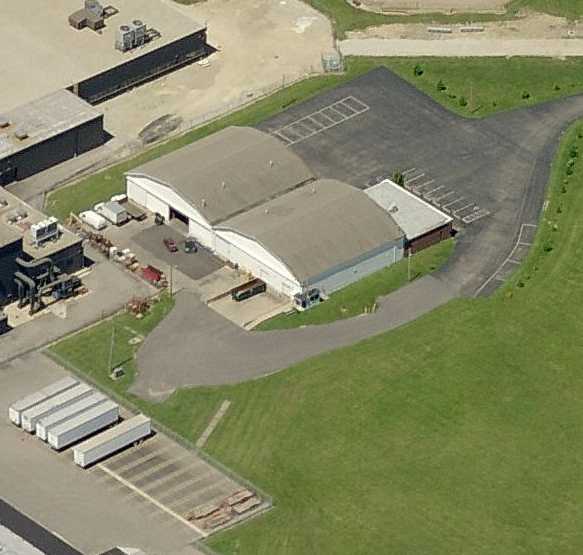
A circa 2007 aerial view looking west at the 2 former Waco hangars on the northwest side of the complex.
The east side of the hangars were marked with “GOKOH Corp.”
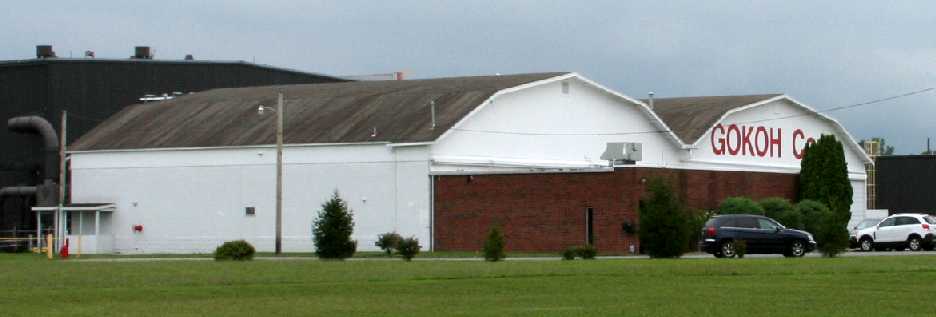
A July 2010 photo by Dick Merrill looking south at the 2 former Waco hangars on the northwest side of the complex.
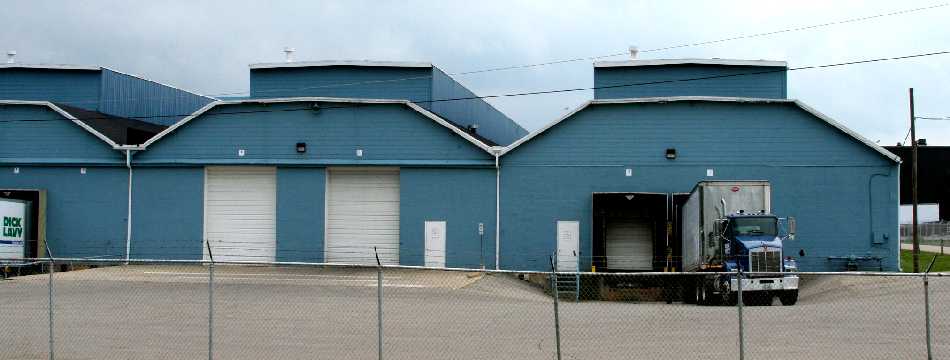
A July 2010 photo by Dick Merrill looking west at the former Waco factory.
The site of the Waco factory is located southwest of the intersection of Peters Road & Archer Drive.
The Waco Air Museum maintains a small museum a short distance away from the former Waco Factory.
____________________________________________________
Since this site was first put on the web in 1999, its popularity has grown tremendously.
That has caused it to often exceed bandwidth limitations
set by the company which I pay to host it on the web.
If the total quantity of material on this site is to continue to grow,
it will require ever-increasing funding to pay its expenses.
Therefore, I request financial contributions from site visitors,
to help defray the increasing costs of the site
and ensure that it continues to be available & to grow.
What would you pay for a good aviation magazine, or a good aviation book?
Please consider a donation of an equivalent amount, at the least.
This site is not supported by commercial advertising –
it is purely supported by donations.
If you enjoy the site, and would like to make a financial contribution,
you
may use a credit card via
![]() ,
using one of 2 methods:
,
using one of 2 methods:
To make a one-time donation of an amount of your choice:
Or you can sign up for a $10 monthly subscription to help support the site on an ongoing basis:
Or if you prefer to contact me directly concerning a contribution (for a mailing address to send a check),
please contact me at: paulandterryfreeman@gmail.com
If you enjoy this web site, please support it with a financial contribution.
please contact me at: paulandterryfreeman@gmail.com
If you enjoy this web site, please support it with a financial contribution.
____________________________________________________
This site covers airfields in all 50 states.